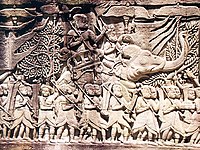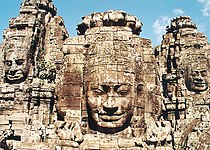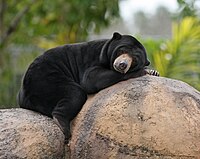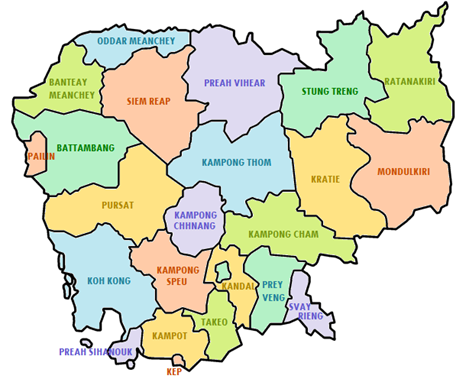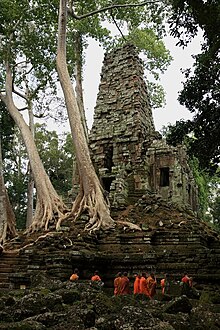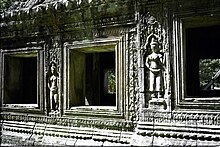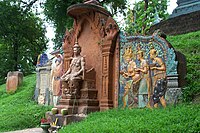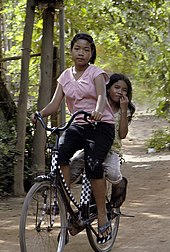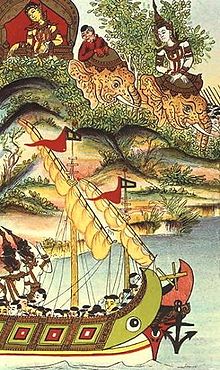through
http://sarvajan.ambedkar.org
sabbe satta bhavantu sukhi-tatta
TIPITAKA
TIPITAKA AND TWELVE DIVISIONS
Brief historical background
Sutta Pitaka
Vinaya Pitaka
Abhidhamma Pitaka
Twelve Divisions of Buddhist Canons
Nine Divisions of Buddhist Canons
Sutta Piṭaka
— The basket of discourses —Mahāsatipaṭṭhāna Sutta (DN 22) {excerpt} - all infobubbles— Attendance on awareness —Kāyānupassanā
IV. சட்டத்துக்கு அடிப்படையான அற முறைகளின் கூர்ந்த கவனிப்பு
D.Bojjhaṅgas மீதான பிரிவு
Dhammapada Verses 292 and 293 Bhaddiyanam bhikkhunam Vatthu - Verse 292. How Blemishes IncreaseVerse 293. Mindfulness Of Physical Reality
ABOUT AWAKEN ONES WITH AWARENESS Cambodia
Prasat Angkor Wat
Angkor
• Angkor Wat
• Bayon
• Krol Ko
• Neak Pean
• Preah Khan
• Preah Palilay
• Ta Prohm
• Ta Som
Wat Preah Keo Morokot
Kampong Thom
• Prasat Kuh Nokor
Phnom Penh
• Wat Botum
• Wat Ounalom
• Wat Phnom
• Wat Preah Keo (Silver Pagoda)
Pursat
• Wat Bakan
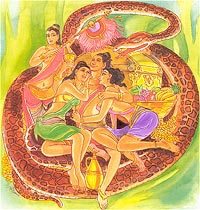 |
Verse 292. How Blemishes Increase
Explanation: If people do what should not be done, and neglect |
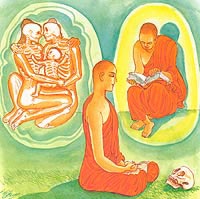 |
Verse 293. Mindfulness Of Physical Reality
Explanation: If one were to practice constantly on the mindfulness |
Dhammapada Verses 292 and 293
Bhaddiyanam bhikkhunam VatthuYam hi kiccam apaviddham
akiccam pana kariyati
unnalanam pamattanam
tesam vaddhanti asava.Yesanca susamaraddha
niccam kayagata sati
akiccam te na sevanti
kicce sataccakarino
satanam Sampajananam
attham gacchanti asava.Verse 292: In those who leave undone what should indeed be done but do what
should not be done, who are conceited and unmindful, moral intoxicants increase.Verse 293: In those who always make a good effort in meditating on the body,
who do not do what should not be done but always do what should be done, who are
also mindful and endowed with clear comprehension, moral intoxicants come to an
end.
The Story of the Baddiya Bhikkhus
While residing near the town of Baddiya, the Buddha uttered Verses (292) and
(293) of this book, with reference to some bhikkhus.Once, some bhikkhus who were staying in Baddiya made some ornate slippers out
of some kinds of reeds and grasses. When the Buddha was told about this he said,
“Bhikkhus, you have entered the Buddhist Order for the sake of attaining
Arahatta Phala. Yet, you are now striving hard only in making slippers and
decorating them.”Then the Buddha spoke in verse as follows:
Verse 292: In those who leave undone what should
indeed be done but do what should not be done, who are conceited and
unmindful, moral intoxicants increase.Verse 293: In those who always make a good effort
in meditating on the body, who do not do what should not be done but
always do what should be done, who are also mindful and endowed with
clear comprehension, moral intoxicants come to an end.
At the end of the discourse, those bhikkhus attained arahatship.
Cambodia
Prasat Angkor Wat
Angkor
• Angkor Wat
http://en.wikipedia.org/wiki/Angkor_Wat
| Angkor Wat | |
|---|---|
 |
|
| Coordinates: | 13°24′45″N 103°52′0″ECoordinates: 13°24′45″N 103°52′0″E |
| Name | |
| Proper name: | Prasat Angkor Wat |
| Location | |
| Country: | Cambodia |
| Location: | Angkor, Siem Reap Province |
| Architecture and culture | |
| Primary deity: | Vishnu |
| Architectural styles: | Khmer, Dravidian |
| History | |
| Date built: (Current structure) |
12th century |
| Creator: | Suryavarman II |
Angkor Wat (Khmer: អង្គរវត្ត) is the largest Hindu temple complex in the world. The temple was built by King Suryavarman II in the early 12th century in Yasodharapura (Khmer: យសោធរបុរៈ, present-day Angkor), the capital of the Khmer Empire, as his state temple and eventual mausoleum. Breaking from the Shaivism tradition of previous kings, Angkor Wat was instead dedicated to Vishnu.
As the best-preserved temple at the site, it is the only one to have
remained a significant religious centre since its foundation – first
Hindu, dedicated to the god Vishnu, then Buddhist. The temple is at the top of the high classical style of Khmer architecture. It has become a symbol of Cambodia,[1] appearing on its national flag, and it is the country’s prime attraction for visitors.
Angkor Wat combines two basic plans of Khmer temple architecture: the temple mountain and the later galleried temple, based on early Dravidian Architecture, with key features such as the Jagati. It is designed to represent Mount Meru, home of the devas in Hindu mythology: within a moat
and an outer wall 3.6 kilometres (2.2 mi) long are three rectangular
galleries, each raised above the next. At the centre of the temple
stands a quincunx
of towers. Unlike most Angkorian temples, Angkor Wat is oriented to the
west; scholars are divided as to the significance of this. The temple
is admired for the grandeur and harmony of the architecture, its
extensive bas-reliefs, and for the numerous devatas adorning its walls.
The modern name, Angkor Wat, means “Temple City” or “City of Temples” in Khmer; Angkor, meaning “city” or “capital city”, is a vernacular form of the word nokor (នគរ), which comes from the Sanskrit word nagar (नगर).[2] Wat is the Khmer word for “temple grounds”, derived from the Pali word “vatta” (वत्त).[3] Prior to this time the temple was known as Preah Pisnulok (Vara Vishnuloka in Sanskrit), after the posthumous title of its founder.[4]
Contents
- 1 History
- 2 Architecture
- 3 Angkor Wat today
- 4 References
- 5 External links
-
History

King Suryavarman II, the builder of Angkor Wat
Angkor Wat lies 5.5 kilometres (3.4 mi) north of the modern town of Siem Reap, and a short distance south and slightly east of the previous capital, which was centred at Baphuon.
It is in an area of Cambodia where there is an important group of
ancient structures. It is the southernmost of Angkor’s main sites.The initial design and construction of the temple took place in the first half of the 12th century, during the reign of Suryavarman II (ruled 1113 – c. 1150). Dedicated to Vishnu, it was built as the king’s state temple and capital city. As neither the foundation stela
nor any contemporary inscriptions referring to the temple have been
found, its original name is unknown, but it may have been known as Vrah Vishnu-lok ( literally “Holy Vishnu’-Location’”, Old Khmer’ Cl. Sanskrit). after the presiding deity. Work seems to have ended shortly after the king’s death, leaving some of the bas-relief decoration unfinished.[5] In 1177, approximately 27 years after the death of Suryavarman II, Angkor was sacked by the Chams, the traditional enemies of the Khmer. Thereafter the empire was restored by a new king, Jayavarman VII, who established a new capital and state temple (Angkor Thom and the Bayon respectively) a few kilometres to the north.In the late 13th century, Angkor Wat gradually moved from Hindu to Theravada Buddhist
use, which continues to the present day. Angkor Wat is unusual among
the Angkor temples in that although it was somewhat neglected after the
16th century it was never completely abandoned, its preservation being
due in part to the fact that its moat also provided some protection from
encroachment by the jungle.[6]One of the first Western visitors to the temple was António da Madalena, a Portuguese
monk who visited in 1586 and said that it “is of such extraordinary
construction that it is not possible to describe it with a pen,
particularly since it is like no other building in the world. It has
towers and decoration and all the refinements which the human genius can
conceive of.”[7] In the mid 19th century the temple was visited by the French naturalist and explorer, Henri Mouhot, who popularised the site in the West through the publication of travel notes, in which he wrote:“One of these temples—a rival to that of Solomon, and erected by some ancient Michelangelo—might take an honourable place beside our most beautiful buildings. It is grander than anything left to us by Greece or Rome, and presents a sad contrast to the state of barbarism in which the nation is now plunged.”[8]
Mouhot, like other early Western visitors, found it difficult to
believe that the Khmers could have built the temple, and mistakenly
dated it to around the same era as Rome. The true history of Angkor Wat
was pieced together only from stylistic and epigraphic
evidence accumulated during the subsequent clearing and restoration
work carried out across the whole Angkor site. There were no ordinary
dwellings or houses or other signs of settlement including cooking
utensils, weapons, or items of clothing usually found at ancient sites.
Instead there is the evidence of the monuments themselves.[9]Facade of Angkor Wat, a drawing by Henri Mouhot Angkor Wat required considerable restoration in the 20th century, mainly the removal of accumulated earth and vegetation.[10] Work was interrupted by the civil war and Khmer Rouge
control of the country during the 1970s and 1980s, but relatively
little damage was done during this period other than the theft and
destruction of mostly post-Angkorian statues.[11]The temple is a powerful symbol of Cambodia, and is a source of great
national pride that has factored into Cambodia’s diplomatic relations
with France, the United States and its neighbour Thailand. A depiction
of Angkor Wat has been a part of Cambodian national flags since the introduction of the first version circa 1863.[12]
From a larger historical and even transcultural perspective, however,
the temple of Angkor Wat did not became a symbol of national pride sui
generis but had been inscribed into a larger politico-cultural process
of French-colonial heritage production in which the original temple site
was presented in French colonial and universal exhibitions in Paris and
Marseille between 1889 and 1937.[13]The splendid artistic legacy of Angkor Wat and other Khmer monuments in the Angkor region led directly to France adopting Cambodia as a protectorate
on 11 August 1863 and invading Siam to take control of the ruins. This
quickly led to Cambodia reclaiming lands in the northwestern corner of
the country that had been under Siamese (Thai) control since 1351 AD
(Manich Jumsai 2001), or by some accounts, 1431 AD.[14] Cambodia gained independence from France on 9 November 1953 and has controlled Angkor Wat since that time.During the midst of the Vietnam War, Chief of State Norodom Sihanouk hosted Jacqueline Kennedy in Cambodia to fulfill her “lifelong dream of seeing Angkor Wat.”[15]
In January 2003 riots erupted in Phnom Penh when a false rumour circulated that a Thai soap opera actress had claimed that Angkor Wat belonged to Thailand.[16]
Architecture
Site and plan
Angkor Wat, located at 13°24′45″N 103°52′0″E, is a unique combination of the temple mountain, the standard design for the empire’s state temples, the later plan of concentric galleries, and influences from Orissa and the Chola of Tamil Nadu, India. The temple is a representation of Mount Meru, the home of the gods: the central quincunx of towers symbolises the five peaks of the mountain, and the walls and moat the surrounding mountain ranges and ocean.[17]
Access to the upper areas of the temple was progressively more
exclusive, with the laity being admitted only to the lowest level.[18]Unlike most Khmer temples, Angkor Wat is oriented to the west rather than the east. This has led many (including Glaize and George Coedès) to conclude that Suryavarman intended it to serve as his funerary temple.[19] Further evidence for this view is provided by the bas-reliefs, which proceed in a counter-clockwise direction—prasavya
in Hindu terminology—as this is the reverse of the normal order.
Rituals take place in reverse order during Brahminic funeral services.[10] The archaeologist Charles Higham also describes a container which may have been a funerary jar which was recovered from the central tower.[20] It has been nominated by some as the greatest expenditure of energy on the disposal of a corpse.[21]
Freeman and Jacques, however, note that several other temples of Angkor
depart from the typical eastern orientation, and suggest that Angkor
Wat’s alignment was due to its dedication to Vishnu, who was associated
with the west.[17]A further interpretation of Angkor Wat has been proposed by Eleanor Mannikka.
Drawing on the temple’s alignment and dimensions, and on the content
and arrangement of the bas-reliefs, she argues that the structure
represents a claimed new era of peace under King Suryavarman II:
“as the measurements of solar and lunar time cycles were built into the
sacred space of Angkor Wat, this divine mandate to rule was anchored to
consecrated chambers and corridors meant to perpetuate the king’s power
and to honor and placate the deities manifest in the heavens above.”[22][23] Mannikka’s suggestions have been received with a mixture of interest and scepticism in academic circles.[20] She distances herself from the speculations of others, such as Graham Hancock, that Angkor Wat is part of a representation of the constellation Draco.[24]Style
Angkor Wat is the prime example of the classical style of Khmer architecture—the Angkor Wat style—to which it has given its name. By the 12th century Khmer architects had become skilled and confident in the use of sandstone (rather than brick or laterite)
as the main building material. Most of the visible areas are of
sandstone blocks, while laterite was used for the outer wall and for
hidden structural parts. The binding agent used to join the blocks is
yet to be identified, although natural resins or slaked lime have been suggested.[25]Angkor Wat has drawn praise above all for the harmony of its design, which has been compared to the architecture of ancient Greece and Rome. According to Maurice Glaize,
a mid-20th-century conservator of Angkor, the temple “attains a classic
perfection by the restrained monumentality of its finely balanced
elements and the precise arrangement of its proportions. It is a work of
power, unity and style.”[26]Architecturally, the elements characteristic of the style include: the ogival, redented towers shaped like lotus buds; half-galleries
to broaden passageways; axial galleries connecting enclosures; and the
cruciform terraces which appear along the main axis of the temple.
Typical decorative elements are devatas (or apsaras), bas-reliefs, and on pediments
extensive garlands and narrative scenes. The statuary of Angkor Wat is
considered conservative, being more static and less graceful than
earlier work.[27] Other elements of the design have been destroyed by looting and the passage of time, including gilded stucco on the towers, gilding on some figures on the bas-reliefs, and wooden ceiling panels and doors.[28]The Angkor Wat style was followed by that of the Bayon period, in which quality was often sacrificed to quantity.[29] Other temples in the style are Banteay Samré, Thommanon, Chao Say Tevoda and the early temples of Preah Pithu at Angkor; outside Angkor, Beng Mealea and parts of Phanom Rung and Phimai.
Features
Outer enclosure
The outer wall, 1024 by 802 m and 4.5 m high, is surrounded by a 30 m
apron of open ground and a moat 190 m wide. Access to the temple is by
an earth bank to the east and a sandstone causeway to the west; the
latter, the main entrance, is a later addition, possibly replacing a
wooden bridge.[30] There are gopuras at each of the cardinal points;
the western is by far the largest and has three ruined towers. Glaize
notes that this gopura both hides and echoes the form of the temple
proper.[31] Under the southern tower is a statue of Vishnu, known as Ta Reach, which may originally have occupied the temple’s central shrine.[30]
Galleries run between the towers and as far as two further entrances on
either side of the gopura often referred to as “elephant gates”, as
they are large enough to admit those animals. These galleries have
square pillars on the outer (west) side and a closed wall on the inner
(east) side. The ceiling between the pillars is decorated with lotus
rosettes; the west face of the wall with dancing figures; and the east
face of the wall with balustered windows, dancing male figures on
prancing animals, and devatas, including (south of the entrance) the only one in the temple to be showing her teeth.The outer wall encloses a space of 820,000 square metres (203 acres),
which besides the temple proper was originally occupied by the city
and, to the north of the temple, the royal palace. Like all secular
buildings of Angkor, these were built of perishable materials rather
than of stone, so nothing remains of them except the outlines of some of
the streets.[32] Most of the area is now covered by forest. A 350 m causeway connects the western gopura to the temple proper, with naga balustrades and six sets of steps leading down to the city on either side. Each side also features a library
with entrances at each cardinal point, in front of the third set of
stairs from the entrance, and a pond between the library and the temple
itself. The ponds are later additions to the design, as is the cruciform
terrace guarded by lions connecting the causeway to the central
structure.[32]Central structure
The temple stands on a terrace raised higher than the city. It is made of three rectangular galleries
rising to a central tower, each level higher than the last. Mannikka
interprets these galleries as being dedicated to the king, Brahma, the moon, and Vishnu.[5] Each gallery has a gopura at each of the points, and the two inner galleries each have towers at their corners, forming a quincunx
with the central tower. Because the temple faces west, the features are
all set back towards the east, leaving more space to be filled in each
enclosure and gallery on the west side; for the same reason the
west-facing steps are shallower than those on the other sides.The outer gallery measures 187 by 215 m, with pavilions rather than
towers at the corners. The gallery is open to the outside of the temple,
with columned half-galleries extending and buttressing the structure.
Connecting the outer gallery to the second enclosure on the west side is
a cruciform cloister called Preah Poan (the “Hall of a Thousand Gods”). Buddha
images were left in the cloister by pilgrims over the centuries,
although most have now been removed. This area has many inscriptions
relating the good deeds of pilgrims, most written in Khmer but others in Burmese and Japanese. The four small courtyards marked out by the cloister may originally have been filled with water.[33] North and south of the cloister are libraries.Beyond, the second and inner galleries are connected to each other
and to two flanking libraries by another cruciform terrace, again a
later addition. From the second level upwards, devatas
abound on the walls, singly or in groups of up to four. The
second-level enclosure is 100 by 115 m, and may originally have been
flooded to represent the ocean around Mount Meru.[34]
Three sets of steps on each side lead up to the corner towers and
gopuras of the inner gallery. The very steep stairways represent the
difficulty of ascending to the kingdom of the gods.[35] This inner gallery, called the Bakan,
is a 60 m square with axial galleries connecting each gopura with the
central shrine, and subsidiary shrines located below the corner towers.
The roofings of the galleries are decorated with the motif of the body
of a snake ending in the heads of lions or garudas. Carved lintels and pediments
decorate the entrances to the galleries and to the shrines. The tower
above the central shrine rises 43 m to a height of 65 m above the
ground; unlike those of previous temple mountains, the central tower is
raised above the surrounding four.[36]
The shrine itself, originally occupied by a statue of Vishnu and open
on each side, was walled in when the temple was converted to Theravada Buddhism,
the new walls featuring standing Buddhas. In 1934, the conservator
George Trouvé excavated the pit beneath the central shrine: filled with
sand and water it had already been robbed of its treasure, but he did
find a sacred foundation deposit of gold leaf two metres above ground level.[37]Decoration
Devatas are characteristic of the Angkor Wat style.
Integrated with the architecture of the building, and one of the
causes for its fame is Angkor Wat’s extensive decoration, which
predominantly takes the form of bas-relief
friezes. The inner walls of the outer gallery bear a series of
large-scale scenes mainly depicting episodes from the Hindu epics the Ramayana and the Mahabharata. Higham has called these, “the greatest known linear arrangement of stone carving”.[38] From the north-west corner anti-clockwise, the western gallery shows the Battle of Lanka (from the Ramayana, in which Rama defeats Ravana) and the Battle of Kurukshetra (from the Mahabharata, showing the mutual annihilation of the Kaurava and Pandava clans). On the southern gallery follow the only historical scene, a procession of Suryavarman II, then the 32 hells and 37 heavens of Hindu mythology.On the eastern gallery is one of the most celebrated scenes, the Churning of the Sea of Milk, showing 92[39] asuras and 88 devas using the serpent Vasuki
to churn the sea under Vishnu’s direction (Mannikka counts only 91
asuras, and explains the asymmetrical numbers as representing the number
of days from the winter solstice to the spring equinox, and from the equinox to the summer solstice).[40] It is followed by Vishnu defeating asuras (a 16th-century addition). The northern gallery shows Krishna’s victory over Bana (where according to Glaize, “The workmanship is at its worst”[41])
and a battle between the Hindu gods and asuras. The north-west and
south-west corner pavilions both feature much smaller-scale scenes, some
unidentified but most from the Ramayana or the life of Krishna.Construction techniques
The stones, as smooth as polished marble, were laid without mortar
with very tight joints that were sometimes hard to find. The blocks were
held together by mortise and tenon
joints in some cases, while in others they used dovetails and gravity.
The blocks were presumably put in place by a combination of elephants, coir
ropes, pulleys and bamboo scaffolding. Henri Mouhot noted that most of
the blocks had holes 2.5 cm in diameter and 3 cm deep, with more holes
on the larger blocks. Some scholars have suggested that these were used
to join them together with iron rods, but others claim they were used to
hold temporary pegs to help manoeuvre them into place.The monument was made out of enormous amounts of sandstone, as much
as Khafre’s pyramid in Egypt (over 5 million tons). This sandstone had
to be transported from Mount Kulen, a quarry approximately 25 miles
(40 km) to the northeast. The stone was presumably transported by raft
along the Siem Reap river. This would have to have been done with care
to avoid overturning the rafts with such a large amount of weight. One
modern engineer estimated it would take 300 years to complete Angkor Wat
today.[42]
Yet the monument was begun soon after Suryavarman came to the throne
and was finished shortly after his death, no more than 40 years.Virtually all of its surfaces, columns, lintels even roofs are carved. There are miles of reliefs illustrating scenes from Indian literature
including unicorns, griffins, winged dragons pulling chariots as well
as warriors following an elephant-mounted leader and celestial dancing
girls with elaborate hair styles. The gallery wall alone is decorated
with almost 1,000 square metres of bas reliefs. Holes on some of the
Angkor walls indicate that they may have been decorated with bronze
sheets. These were highly prized in ancient times and were a prime
target for robbers. While excavating Khajuraho, Alex Evans, a stonemason
and sculptor, recreated a stone sculpture under 4 feet (1.2 m), this
took about 60 days to carve.[43]
Roger Hopkins and Mark Lehner also conducted experiments to quarry
limestone which took 12 quarrymen 22 days to quarry about 400 tons of
stone.[44]
The labour force to quarry, transport, carve and install so much
sandstone must have run into the thousands including many highly skilled
artisans. The skills required to carve these sculptures were developed
hundreds of years earlier, as demonstrated by some artifacts that have
been dated to the seventh century, before the Khmer came to power.[21][42]…Angkor Wat today
World Monuments Fund video on conservation of Angkor Wat
The Archaeological Survey of India carried out restoration work on the temple between 1986 and 1992.[45]
Since the 1990s, Angkor Wat has seen continued conservation efforts and
a massive increase in tourism. The temple is part of the Angkor World Heritage Site, established in 1992, which has provided some funding and has encouraged the Cambodian government to protect the site.[46] The German Apsara Conservation Project (GACP) is working to protect the devatas
and other bas-reliefs which decorate the temple from damage. The
organisation’s survey found that around 20% of the devatas were in very
poor condition, mainly because of natural erosion and deterioration of
the stone but in part also due to earlier restoration efforts.[47]
Other work involves the repair of collapsed sections of the structure,
and prevention of further collapse: the west facade of the upper level,
for example, has been buttressed by scaffolding since 2002,[48] while a Japanese team completed restoration of the north library of the outer enclosure in 2005.[49] World Monuments Fund began work on the Churning of the Sea of Milk Gallery in 2008.Angkor Wat has become a major tourist destination. In 2004 and 2005,
government figures suggest that, respectively, 561,000 and 677,000
foreign visitors arrived in Siem Reap province, approximately 50% of all
foreign tourists in Cambodia for both years.[50] The site has been managed by the private SOKIMEX
group since 1990, which rented it from the Cambodian government. The
influx of tourists has so far caused relatively little damage, other
than some graffiti;
ropes and wooden steps have been introduced to protect the bas-reliefs
and floors, respectively. Tourism has also provided some additional
funds for maintenance—as of 2000 approximately 28% of ticket revenues
across the whole Angkor
site was spent on the temples—although most work is carried out by
foreign government-sponsored teams rather than by the Cambodian
authorities.[51]At the ASEAN Tourism Forum 2012, both parties have agreed Borobudur
and Angkor Wat to become sister sites and the provinces will become
sister provinces. Two Indonesian airlines are considering the
opportunity to open a direct flight from Yogyakarta, Indonesia to Siem Reap.[52]
• Bayon
http://en.wikipedia.org/wiki/Bayon
| Bayon | |
|---|---|
 |
|
|
|
|
| Coordinates: | 13°26′28″N 103°51′31″ECoordinates: 13°26′28″N 103°51′31″E |
| Name | |
| Proper name: | Prasat Bayon |
| Location | |
| Country: | Cambodia |
| Location: | Angkor Thom |
| Architecture and culture | |
| Primary deity: | Buddha, Avalokiteshvara |
| Architectural styles: | Khmer |
| History | |
| Date built: (Current structure) |
end of 12th c. CE |
| Creator: | Jayavarman VII |

According to Angkor-scholar Maurice Glaize, the Bayon appears “as but a muddle of stones, a sort of moving chaos assaulting the sky.”[1]

From the vantage point of the temple’s upper terrace, one is struck by “the serenity of the stone faces” occupying many towers.[1]
The Bayon (Khmer: ប្រាសាទបាយ័ន, Prasat Bayon) is a well-known and richly decorated Khmer temple at Angkor in Cambodia. Built in the late 12th century or early 13th century as the official state temple of the Mahayana Buddhist King Jayavarman VII, the Bayon stands at the centre of Jayavarman’s capital, Angkor Thom. Following Jayavarman’s death, it was modified and augmented by later Hindu and Theravada Buddhist kings in accordance with their own religious preferences.
The Bayon’s most distinctive feature is the multitude of serene and
massive stone faces on the many towers which jut out from the upper
terrace and cluster around its central peak.[2] The temple is known also for two impressive sets of bas-reliefs, which present an unusual combination of mythological, historical, and mundane scenes. The current main conservatory body, the Japanese Government team for the Safeguarding of Angkor (the JSA) has described the temple as “the most striking expression of the baroque style” of Khmer architecture, as contrasted with the classical style of Angkor Wat.[3]
Contents |
History
Buddhist symbolism in the foundation of the temple by King Jayavarman VII
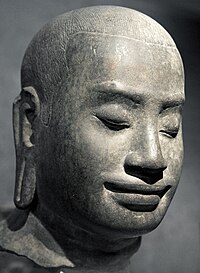
According to scholars, King Jayavarman VII bears a strong resemblance to the face towers of the Bayon.
The Bayon was the last state temple to be built at Angkor, and the only Angkorian state temple to be built primarily as a Mahayana Buddhist shrine dedicated to the Buddha,
though a great number of minor and local deities were also encompassed
as representatives of the various districts and cities of the realm. It
was the centrepiece of Jayavarman VII’s massive program of monumental construction and public works, which was also responsible for the walls and nāga-bridges of Angkor Thom and the temples of Preah Khan, Ta Prohm and Banteay Kdei.
The similarity of the 216 gigantic faces on the temple’s towers to
other statues of the king has led many scholars to the conclusion that
the faces are representations of Jayavarman VII himself. Others have said that the faces belong to the bodhisattva of compassion called Avalokitesvara or Lokesvara.[4] The two hypotheses need not be regarded as mutually exclusive. Angkor scholar George Coedès
has theorized that Jayavarman stood squarely in the tradition of the
Khmer monarchs in thinking of himself as a “devaraja” (god-king), the
salient difference being that while his predecessors were Hindus and
regarded themselves as consubstantial with Shiva and his symbol the lingam, Jayavarman as a Buddhist identified himself with the Buddha and the bodhisattva.[5]
Alterations following the death of Jayavarman VII
Since the time of Jayavarman VII, the Bayon has suffered numerous additions and alterations at the hands of subsequent monarchs.[1] During the reign of Jayavarman VIII in the mid-13th century, the Khmer empire reverted to Hinduism and its state temple was altered accordingly. In later centuries, Theravada Buddhism
became the dominant religion, leading to still further changes, before
the temple was eventually abandoned to the jungle. Current features
which were not part of the original plan include the terrace to the east
of the temple, the libraries, the square corners of the inner gallery, and parts of the upper terrace.
Modern restoration
In the first part of the 20th century, the École Française d’Extrême Orient took the lead in the conservation of the temple, restoring it in accordance with the technique of anastylosis.
Since 1995 the Japanese Government team for the Safeguarding of Angkor
(the JSA) has been the main conservatory body, and has held annual
symposia.
The site
The temple is oriented towards the east, and so its buildings are set
back to the west inside enclosures elongated along the east-west axis.
Because the temple sits at the exact centre of Angkor Thom, roads lead to it directly from the gates at each of the city’s cardinal points. The temple itself has no wall or moats,
these being replaced by those of the city itself: the city-temple
arrangement, with an area of 9 square kilometres, is much larger than
that of Angkor Wat
to the south (2 km²). Within the temple itself, there are two galleried
enclosures (the third and second enclosures) and an upper terrace (the
first enclosure). All of these elements are crowded against each other
with little space between. Unlike Angkor Wat,
which impresses with the grand scale of its architecture and open
spaces, the Bayon “gives the impression of being compressed within a
frame which is too tight for it.”[6]
The outer gallery: historical events and everyday life
The outer wall of the outer gallery features a series of bas-reliefs
depicting historical events and scenes from the everyday life of the
Angkorian Khmer. Though highly detailed and informative in themselves,
the bas-reliefs are not accompanied by any sort of epigraphic text, and
for that reason considerable uncertainty remains as to which historical
events are portrayed and how, if at all, the different reliefs are
related.[7] From the east gopura clockwise, the subjects are:
- in the southern part of the eastern gallery a marching Khmer army (including some Chinese soldiers),[8] with musicians, horsemen, and officers mounted on elephants, followed by wagons of provisions;
- still in the eastern gallery, on the other side of the doorway
leading into the courtyard, another procession followed by domestic
scenes depicting Angkorian houses, some of the occupants of which appear
to be Chinese merchants; - in the southeast corner pavilion, an unfinished temple scene with towers, apsaras, and a lingam;
- in the eastern part of the southern gallery, a naval battle on the Tonle Sap between Khmer and Cham forces,[9]
underneath which are more scenes from civilian life depicting a market,
open-air cooking, hunters, and women tending to children and an
invalid; - still in the southern gallery, past the doorway leading to the
courtyard, a scene with boats and fisherman, including a Chinese junk,
below which is a depiction of a cockfight;
then some palace scenes with princesses, servants, people engaged in
conversations and games, wrestlers, and a wild boar fight; then a battle
scene with Cham warriors disembarking from boats and engaging Khmer
warriors whose bodies are protected by coiled ropes, followed by a scene
in which the Khmer dominate the combat, followed by a scene in which
the Khmer king celebrates a victory feast with his subjects; - in the western part of the southern gallery, a military procession
including both Khmers and Chams, elephants, war machines such as a large
crossbow and a catapult; - in the southern part of the western gallery, unfinished reliefs show
an army marching through the forest, then arguments and fighting
between groups of Khmers;[10] - in the western gallery, past the doorway to the courtyard, a scene
depicting a melee between Khmer warriors, then a scene in which warriors
pursue others past a pool in which an enormous fish swallows a small
deer;[11] then a royal procession, with the king standing on an elephant, preceded by the ark of the sacred flame; - in the western part of the northern gallery, again unfinished, a
scene of royal entertainment including athletes, jugglers and acrobats, a
procession of animals, ascetics sitting in a forest, and more battles
between Khmer and Cham forces; - in the northern gallery, past the doorway to the courtyard, a scene
in which the Khmer flee from Cham soldiers advancing in tight ranks; - in the northeast corner pavilion, another marching Khmer army;
- in the eastern gallery, a land battle between Khmer and Cham forces,
both of which are supported by elephants: the Khmer appear to be
winning.
The outer gallery encloses a courtyard in which there are two
libraries (one on either side of the east entrance). Originally the
courtyard contained 16 chapels, but these were subsequently demolished
by the Hindu restorationist Jayavarman VIII.
The inner gallery: depictions of mythological events
The inner gallery is raised above ground level and has doubled
corners, with the original redented cross-shape later filled out to a
square. Its bas-reliefs, later additions of Jayavarman VIII, are in
stark contrast to those of the outer: rather than set-piece battles and
processions, the smaller canvases offered by the inner gallery are
decorated for the most part with scenes from Hindu mythology. Some of the figures depicted are Siva, Vishnu, and Brahma, the members of the trimurti or threefold godhead of Hinduism, Apsaras or celestial dancers, Ravana and Garuda.[12]
There is however no certainty as to what some of the panels depict, or
as to their relationship with one another. One gallery just north of the
eastern gopura,
for example, shows two linked scenes which have been explained as the
freeing of a goddess from inside a mountain, or as an act of iconoclasm
by Cham invaders.[13]
Another series of panels shows a king fighting a gigantic serpent with
his bare hands, then having his hands examined by women, and finally
lying ill in bed; these images have been connected with the legend of
the Leper King, who contracted leprosy from the venom of a serpent with
whom he had done battle.[14] Less obscure are depictions of the construction of a Vishnuite temple (south of the western gopura) and the Churning of the Sea of Milk (north of the western gopura).
The upper terrace: 200 faces of Lokesvara
The inner gallery is nearly filled by the upper terrace, raised one
level higher again. The lack of space between the inner gallery and the
upper terrace has led scholars to conclude that the upper terrace did
not figure in the original plan for the temple, but that it was added
shortly thereafter following a change in design. Originally, it is
believed, the Bayon had been designed as a single-level structure,
similar in that respect to the roughly contemporaneous foundations at Ta Prohm and Banteay Kdei.[15]
The upper terrace is home to the famous “face towers” of the Bayon,
each of which supports two, three or (most commonly) four gigantic
smiling faces. In addition to the mass of the central tower, smaller
towers are located along the inner gallery (at the corners and
entrances), and on chapels on the upper terrace. “Wherever one wanders,”
writes Maurice Glaize, the faces of Lokesvara follow and dominate with their multiple presence.”[16]
Efforts to read some significance into the numbers of towers and
faces have run up against the circumstance that these numbers have not
remained constant over time, as towers have been added through
construction and lost to attrition. At one point, the temple was host to
49 such towers; now only 37 remain.[2] The number of faces is approximately 200, but since some are only partially preserved there can be no definitive count.
The central tower and sanctuary
Like the inner gallery, the central tower was originally cruciform
but was later filled out and made circular. It rises 43 metres above the
ground. At the time of the temple’s foundation, the principal religious
image was a statue of the Buddha, 3.6 m tall, located in the sanctuary
at the heart of the central tower. The statue depicted the Buddha
seated in meditation, shielded from the elements by the flared hood of
the serpent king Mucalinda. During the reign of Hindu restorationist monarch Jayavarman VIII,
the figure was removed from the sanctuary and smashed to pieces. After
being recovered in 1933 from the bottom of a well, it was pieced back
together, and is now on display in a small pavilion at Angkor.[17]
Images of the Bayon
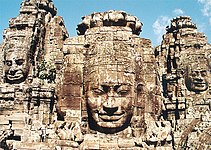 |
 |
 |
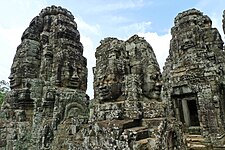 |
• Krol Ko
http://en.wikipedia.org/wiki/Krol_Ko
Krol Ko at Angkor, Cambodia, is a Buddhist temple built at the end of the 12th century under the rule of Jayavarman VII. It is north of Neak Pean.
|
||||||||||||||||||||||
Coordinates: 13°28′5″N 103°53′42″E
| This article about a building or structure in Cambodia is a stub. You can help Wikipedia by expanding it. |
| This article about a Buddhist monastery, temple or nunnery is a stub. You can help Wikipedia by expanding it. |
| Kingdom of Cambodia | ||||||
|---|---|---|---|---|---|---|
|
||||||
| Motto: Nation, Religion, King |
||||||
| Anthem: Nokor Reach Majestic Kingdom |
||||||
| Capital (and largest city) |
Phnom Penh 11°33′N 104°55′E |
|||||
| Official language(s) | Khmer | |||||
| Official script | Khmer script | |||||
| Ethnic groups | 90.0% Khmer 5.0% Vietnamese 1.0% Chinese 4.0% other |
|||||
| Demonym | Khmer or Cambodian | |||||
| Government | Unitary parliamentary constitutional monarchy | |||||
| - | King | Norodom Sihamoni | ||||
| - | Prime Minister | Hun Sen (CPP) | ||||
| - | Senate President | Chea Sim (CPP) | ||||
| - | President of National Assembly | Heng Samrin (CPP) | ||||
| Legislature | Parliament | |||||
| - | Upper house | Senate | ||||
| - | Lower house | National Assembly | ||||
| Formation | ||||||
| - | Funan Kingdom | 68 | ||||
| - | Chenla Kingdom | 550 | ||||
| - | Khmer Empire | 802 | ||||
| - | French Colonization | 1863 | ||||
| - | Independence from France | November 9, 1953 | ||||
| - | Monarchy Restored | September 24, 1993 | ||||
| Area | ||||||
| - | Total | 181,035 km2 (88th) 69,898 sq mi |
||||
| - | Water (%) | 2.5 | ||||
| Population | ||||||
| - | 2010 estimate | 14,138,000[1] (65th) | ||||
| - | 2008 census | 13,388,910[2] | ||||
| - | Density | 81.8/km2 (118th) 211.8/sq mi |
||||
| GDP (PPP) | 2012 estimate | |||||
| - | Total | $36.010 billion[3] | ||||
| - | Per capita | $2,361[3] | ||||
| GDP (nominal) | 2012 (est.) estimate | |||||
| - | Total | $14.204 billion[3] | ||||
| - | Per capita | $931[3] | ||||
| Gini (2007) | 43[4] (medium) | |||||
| HDI (2011) | ||||||
| Currency | Riel (KHR) |
|||||
| Time zone | (UTC+7) | |||||
| Drives on the | right | |||||
| ISO 3166 code | KH | |||||
| Internet TLD | .kh | |||||
| Calling code | +855 | |||||
| 1 | The US Dollar is often used | |||||
Cambodia (![]() i/kæmˈboʊdiə/;[6] Khmer: ព្រះរាជាណាចក្រកម្ពុជា, Kampuchea, IPA: [kɑmˈpuˈciə]), officially known as the Kingdom of Cambodia, is a country located in the southern portion of the Indochina Peninsula in Southeast Asia. With a total landmass of 181,035 square kilometres (69,898 sq mi), it is bordered by Thailand to the northwest, Laos to the northeast, Vietnam to the east, and the Gulf of Thailand to the southwest.
i/kæmˈboʊdiə/;[6] Khmer: ព្រះរាជាណាចក្រកម្ពុជា, Kampuchea, IPA: [kɑmˈpuˈciə]), officially known as the Kingdom of Cambodia, is a country located in the southern portion of the Indochina Peninsula in Southeast Asia. With a total landmass of 181,035 square kilometres (69,898 sq mi), it is bordered by Thailand to the northwest, Laos to the northeast, Vietnam to the east, and the Gulf of Thailand to the southwest.
With a population of over 14.8 million, Cambodia is the 68th most populous country in the world. The official religion is Theravada Buddhism, which is practiced by approximately 95% of the Cambodian population. The country’s minority groups include Vietnamese, Chinese, Chams and 30 various hill tribes.[7] The capital and largest city is Phnom Penh; the political, economic, and cultural center of Cambodia. The kingdom is a constitutional monarchy with Norodom Sihamoni, a monarch chosen by the Royal Throne Council, as head of state. The head of government is Hun Sen, who is currently the longest serving leader in South East Asia and has ruled Cambodia for over 25 years.
In 802 AD Jayavarman II declared himself king marking the beginning of the Khmer Empire
which flourished for over 600 years and allowing successive kings to
dominate much of Southeast Asia and accumulate immense power and wealth.
The Indianized kingdom built monumental temples such as Angkor Wat and facilitated the spread of first Hinduism, then Buddhism to much of Southeast Asia. After the fall of Angkor to Ayutthaya
in the 15th century, Cambodia was ruled as a vassal between its
neighbors until it was colonized by the French in the mid-19th century.
Cambodia gained independence in 1953.
The Vietnam War extended into Cambodia, giving rise to the Khmer Rouge, which took Phnom Penh in 1975. Cambodia reemerged several years later within a socialistic sphere of influence as the People’s Republic of Kampuchea
until 1993. After years of isolation, the war-ravaged nation was
reunited under the monarchy in 1993 and has seen rapid progress in the
economic and human resource areas while rebuilding from decades of civil war.
Cambodia has had one of the best economic records in Asia, with
economic growth averaging 6.0% for the last 10 years. Strong textiles,
agriculture, construction, garments, and tourism sectors led to foreign
investments and international trade.[8]
In 2005, oil and natural gas deposits were found beneath Cambodia’s
territorial waters, and once commercial extraction begins in 2013, the
oil revenues could profoundly affect Cambodia’s economy.[9]
Contents |
Name
The official name of the country in English is the “Kingdom of Cambodia”, translated from the Khmer “/preăh riəchiənaːchaʔ kampuciə/“, often shortened to just “Kampuchea” (Khmer: កម្ពុជា). Colloquially, Cambodians most often refer to their country as ស្រុកខ្មែរ (Khmer pronunciation: [srok kʰmae], Srok Khmer), meaning “The Land of the Khmers” or by using the slightly more formal form ប្រទេសកម្ពុជា (Khmer pronunciation: [prɑteːh kampuciə], Prateh Kampuchea),
literally “The Country of Cambodia”. The English form “Cambodia” is
derived from “Cambodge”, the French transcription of “Kampuchea”.
History
Pre-history
There is sparse evidence for a Pleistocene human occupation of present day Cambodia, which includes quartz and quartzite pebble tools found in terraces along the Mekong River, in Stung Treng and Kratié provinces, and in Kampot Province, although their dating is unreliable.[10]
Some slight archaeological evidence shows communities of hunter-gatherers inhabited Cambodia during Holocene: the most ancient Cambodian archeological site is considered to be the cave of L’aang Spean, in Battambang Province, which belongs to the Hoabinhian period. Excavations in its lower layers produced a series of radiocarbon dates as of 6000 BC.[10][11]
Upper layers in the same site gave evidence of transition to Neolithic, containing the earliest dated earthenware ceramics in Cambodia[12]
Archeological records for the period between Holocene and Iron Age remain equally limited. Other prehistoric sites of somewhat uncertain date are Samrong Sen (not far from the ancient capital of Udong), where the first investigations began in 1877,[13] and Phum Snay, in the northern province of Banteay Meanchey.[14] Prehistoric artifacts are often found during mining activities in Ratanakiri.[10]
The most curious prehistoric evidence in Cambodia however is the various “circular earthworks“, discovered in the red soils near Memot
and in the adjacent region of Vietnam in the latter 1950s. Their
function and age are still debated, but some of them possibly date from
2nd millennium BC at least.[15][16]
A pivotal event in Cambodian prehistory was the slow penetration of
the first rice farmers from the north, which began in the late 3rd
millennium BC.[17]
Iron was worked by about 500 BC, with supporting evidence coming from the Khorat Plateau, in modern day Thailand. In Cambodia, some Iron Age settlements were found beneath Baksei Chamkrong and other Angkorian temples while circular earthworks, were found beneath Lovea
a few kilometers north-west of Angkor. Burials, much richer than other
types of finds, testify to improvement of food availability and trade
(even on long distances: in the 4th century BC trade relations with
India were already opened) and the existence of a social structure and
labor organization.[17]
Pre-Angkorian era and Angkorian era
During the 3rd, 4th, and 5th centuries, the Indianized states of Funan and its successor, Chenla, coalesced in present-day Cambodia and southwestern Vietnam. For more than 2,000 years, Cambodia absorbed influences from India, passing them on to other Southeast Asian civilizations that are now Thailand and Laos.[18]
Little else is known for certain of these polities, however Chinese
chronicles and tribute records do make mention of them. The chronicles
suggest that after Jayavarman I of Chenla died around 690, turmoil
ensued which resulted in division of the kingdom into Land Chenla and
Water Chenla which was loosely ruled by weak princes under the dominion
of Java.
The Khmer Empire grew out of these remnants of Chenla becoming firmly established in 802 when Jayavarman II (reigned c790-850) declared independence from Java and proclaimed himself a Devaraja. He and his followers instituted the cult of the God-king and began a series of conquests that formed an empire which flourished in the area from the 9th to the 15th centuries.[19] Around the 13th century, monks from Sri Lanka introduced Theravada Buddhism to Southeast Asia.[20] The religion spread and eventually displaced Hinduism and Mahayana Buddhism as the popular religion of Angkor.
The Khmer Empire was Southeast Asia’s largest empire during the 12th century. The empire’s center of power was Angkor,
where a series of capitals was constructed during the empire’s zenith.
In 2007 an international team of researchers using satellite photographs
and other modern techniques concluded that Angkor had been the largest
pre-industrial city in the world with an urban sprawl of 1,150 square
miles.[21] The city, which could have supported a population of up to one million people[22] and Angkor Wat,
the most well known and best-preserved religious temple at the site,
still serve as reminders of Cambodia’s past as a major regional power.
The empire, though in decline, remained a significant force in the
region until its fall in the 15th century.
Dark ages of Cambodia

The ancient city of Longvek
After a long series of wars with neighboring kingdoms, Angkor was sacked by the Ayutthaya Kingdom and abandoned in 1432 because of ecological failure and infrastructure breakdown.[23][24]
This led to a period of economic, social, and cultural stagnation when
the kingdom’s internal affairs came increasingly under the control of
its neighbors. By this time, the Khmer penchant for monument building
had ceased. Older faiths such as Mahayana Buddhism and the Hindu cult of the god-king had been supplanted by Theravada Buddhism for good.
The court moved the capital to Longvek where the kingdom sought to regain its glory through maritime trade. Portuguese and Spanish travelers described the city as a place of flourishing wealth and foreign trade.
The attempt was short-lived however, as continued wars with Ayutthaya
and the Vietnamese resulted in the loss of more territory and Longvek
being conquered and destroyed by King Naresuan the Great of Ayutthaya in 1594. A new Khmer capital was established at Udong south of Longvek in 1618, but its monarchs could survive only by entering into what amounted to alternating vassal
relationships with the Siamese and Vietnamese for the next three
centuries with only a few short-lived periods of relative independence.
In the nineteenth century a renewed struggle between Siam and Vietnam
for control of Cambodia resulted in a period when Vietnamese officials
attempted to force the Khmers to adopt Vietnamese customs. This led to several rebellions against the Vietnamese and appeals to Thailand for assistance. The Siamese–Vietnamese War (1841–1845) ended with an agreement to place the country under joint suzerainty. This later led to the signing of a treaty for French Protection of Cambodia by King Norodom I.
French colonization
In 1863, King Norodom, who had been installed by Thailand,[25]
sought the protection of France from the Thai and Vietnamese after
tensions grew between them. In 1867 the Thai king signed a treaty with
France, renouncing suzerainty over Cambodia in exchange for the control of Battambang and Siem Reap
provinces which officially became part of Thailand. The provinces were
ceded back to Cambodia by a border treaty between France and Thailand in
1906.
Cambodia continued as a protectorate of France from 1863 to 1953, administered as part of the colony of French Indochina, though occupied by the Japanese empire from 1941 to 1945.[26] Between 1874 and 1962, the total population increased from about 946,000 to 5.7 million.[27]
After King Norodom’s death in 1904, France manipulated the choice of
king, and Sisowath, Norodom’s brother, was placed on the throne. The
throne became vacant in 1941 with the death of Monivong, Sisowath’s son,
and France passed over Monivong’s son, Monireth, feeling he was too
independently minded. Instead, Norodom Sihanouk, a maternal grand-son of king Sisowath was enthroned. The French thought young Sihanouk would be easy to control.[26]
They were wrong, however, and under the reign of King Norodom Sihanouk,
Cambodia gained independence from France on November 9, 1953.[26]
Independence and Vietnam War
Cambodia became a constitutional monarchy under King Norodom Sihanouk. When French Indochina was given independence, Cambodia lost hope of regaining control over the Mekong Delta as it was awarded to Vietnam. Formerly part of the Khmer Empire, the area had been controlled by the Vietnamese since 1698 with King Chey Chettha II granting Vietnamese permission to settle in the area decades before.[28] This remains a diplomatic sticking point with over one million ethnic Khmers (the Khmer Krom)
still living in this region. The Khmer Rouge attempted invasions to
recover the territory which, in part, led to Vietnam’s invasion of
Cambodia and usurpation of the Khmer Rouge.
In 1955, Sihanouk abdicated in favor of his father in order to
participate in politics and was elected prime minister. Upon his
father’s death in 1960, Sihanouk again became head of state, taking the
title of prince. As the Vietnam War progressed, Sihanouk adopted an official policy of neutrality in the Cold War,
although he was widely considered to be sympathetic to the communist
cause. Sihanouk allowed the Vietnamese communists to use Cambodia as a
sanctuary and a supply route for their arms and other aid to their armed
forces fighting in South Vietnam. This policy was perceived as
humiliating by many Cambodians. In December 1967 Washington Post
journalist Stanley Karnow was told by Sihanouk that if the US wanted to
bomb the Vietnamese communist sanctuaries, he would not object, unless
Cambodians were killed.[29] The same message was conveyed to US President Johnson’s emissary Chester Bowles in January 1968.[30]
So the US had no real motivation to overthrow Sihanouk. However members
of the government and army, who resented Sihanouk’s ruling style as
well as his tilt away from the United States, did have such a
motivation. While visiting Beijing in 1970 Sihanouk was ousted by a military coup led by Prime Minister General Lon Nol and Prince Sisowath Sirik Matak.
There is no evidence of any US role in the coup. However once the coup
was completed the new regime, which immediately demanded that the
Vietnamese communists leave Cambodia, gained the political support of
the United States. The North Vietnamese and Viet Cong forces, desperate
to retain their sanctuaries and supply lines from North Vietnam,
immediately launched armed attacks on the new government. The king urged
his followers to help in overthrowing this government, hastening the
onset of civil war,[31] Soon the Khmer Rouge
rebels began using him to gain support. However from 1970 until early
1972 the Cambodian conflict was largely one between the government and
army of Cambodia, and the armed forces of North Vietnam. As they gained
control of Cambodian territory the Vietnamese communists imposed a new
political infrastructure, which was eventually dominated by the
Cambodian communists we now refer to as the Khmer Rouge.[32] So the Vietnamese communists played a vital role in the rise of the Khmer Rouge.
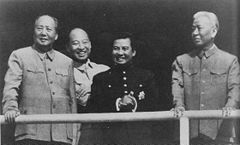
Norodom Sihanouk and Mao Tse-Tung in 1956
Between 1969 and 1973, Republic of Vietnam forces and U.S. forces bombed and briefly invaded Cambodia in an effort to disrupt the Viet Cong and Khmer Rouge.[33] Some two million Cambodians were made refugees
by the war and by the terrorist policies of the Khmer Rouge, and fled
to Phnom Penh. Estimates of the number of Cambodians killed during the
bombing campaigns vary widely, as do views of the effects of the
bombing. The U.S. Seventh Air Force argued that the bombing prevented
the fall of Phnom Penh in 1973 by killing 16,000 of 25,500 Khmer Rouge
fighters besieging the city.[34] However, journalist William Shawcross and Cambodia specialists Milton Osborne, David P. Chandler and Ben Kiernan argued that the bombing drove peasants to join the Khmer Rouge.[35]
Cambodia specialist Craig Etcheson argued that the Khmer Rouge “would
have won anyway”, even without U.S. intervention driving recruitment.[36] American diplomat Timothy M. Carney argued that the five reasons why Pol Pot won the war were: support from Sihanouk,
massive supplies of military aid from North Vietnam, government
corruption, the U.S. cut-off in air support after Watergate, and the
determination of the Cambodian Communists. Not one of them in his
opinion was the U.S. bombing.[37]
Khmer Republic (1970-1975)
| This section requires expansion. (July 2012) |
Khmer Rouge regime
As the Vietnam War ended, a draft USAID
report observed that the country faced famine in 1975, with 75% of its
draft animals destroyed, and that rice planting for the next harvest
would have to be done “by the hard labour of seriously malnourished
people”. The report predicted that
“Without large-scale external food and equipment assistance there
will be widespread starvation between now and next February … Slave
labour and starvation rations for half the nation’s people (probably
heaviest among those who supported the republic) will be a cruel
necessity for this year, and general deprivation and suffering will
stretch over the next two or three years before Cambodia can get back to
rice self-sufficiency”.[38]
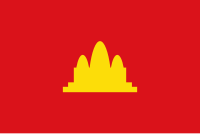
Flag of the Khmer Rouge and Democratic Kampuchea
The Khmer Rouge reached Phnom Penh and took power in 1975. The regime, led by Pol Pot, changed the official name of the country to Democratic Kampuchea.
The regime modelled itself on Maoist China during the Great Leap
Forward. The regime immediately evacuated the cities and sent the entire
population on forced marches to rural work projects. They attempted to
rebuild the country’s agriculture on the model of the 11th century,
discarded Western medicine, and destroyed temples, libraries, and
anything considered Western. At least a million Cambodians, out of a
total population of 8 million, died from executions, overwork,
starvation and disease.[39]
Estimates as to how many people were killed by the Khmer Rouge regime
range from approximately one to three million; the most commonly cited
figure is two million (about one-third of the population).[40][41] This era gave rise to the term Killing Fields, and the prison Tuol Sleng
became notorious for its history of mass killing. Hundreds of thousands
fled across the border into neighbouring Thailand. The regime
disproportionately targeted ethnic minority groups. The Cham Muslims suffered serious purges with as much as half of their population exterminated.[42]
In the late 1960s, an estimated 425,000 ethnic Chinese
lived in Cambodia, but by 1984, due to Khmer Rouge killings and to
emigration, only about 61,400 Chinese remained in the country.[43] Forced repatriation in 1970 and deaths during the Khmer Rouge era reduced the Vietnamese population in Cambodia from between 250,000 and 300,000 in 1969 to a reported 56,000 in 1984.[27]
However most of the victims of the Khmer Rouge regime were not ethnic
minorities but ethnic Khmer. Professionals, such as doctors, lawyers and
teachers, were also targeted. According to Robert D. Kaplan, “eyeglasses were as deadly as the yellow star” as they were seen as a sign of intellectualism.[39]
Vietnamese occupation and transition
In November 1978, Vietnamese troops invaded Cambodia in response to border raids by the Khmer Rouge.[44] The People’s Republic of Kampuchea (PRK), a Pro-Soviet
state led by the Kampuchean People’s Revolutionary Party, a party
created by the Vietnamese in 1951, and led by a group of Khmer Rouge who
had fled Cambodia to avoid being purged by Pol Pot and Ta Mok, was
established.[45]
It was fully beholden to the occupying Vietnamese army and under
direction of the Vietnamese ambassador to Phnom Penh. Its arms came from
Vietnam and the Soviet Union. In opposition to the newly-created state,
a government-in-exile referred to as the Coalition Government of Democratic Kampuchea (CGDK) was formed in 1981 from three factions. This consisted of the Khmer Rouge, a royalist faction led by Sihanouk, and the Khmer People’s National Liberation Front.
Its credentials were recognized by the United Nations. The Khmer Rouge
representative to the UN, Thiounn Prasith, was retained, but he had to
work in consultation with representatives of the noncommunist Cambodian
parties.[46][47]
Throughout the 1980s the CGDK, supplied by China, Thailand, the United States[48] and the United Kingdom[49][50]
controlled parts of the country and attacked some of the territory not
under their dominance. The refusal of Vietnam to withdraw from Cambodia
led to economic sanctions[51] by the U.S. and its allies, made reconstruction virtually impossible and left the country deeply impoverished.
Peace efforts began in Paris in 1989 under the State of Cambodia,
culminating two years later in October 1991 in a comprehensive peace
settlement. The UN was given a mandate to enforce a ceasefire and deal
with refugees and disarmament known as the United Nations Transitional Authority in Cambodia (UNTAC).[52]
In 1993, Norodom Sihanouk was restored as King of Cambodia,
but all power was in the hands of the government established after the
UNTAC sponsored elections. The stability established following the
conflict was shaken in 1997 by a coup d’état led by the co-Prime
Minister Hun Sen against the noncommunist parties in the government.[53]
Many of the noncommunist politicians were murdered by Hun Sen’s forces.
In recent years, reconstruction efforts have progressed and led to some
political stability through political repression of a multiparty democracy under a constitutional monarchy.[54] In July 2010 Kang Kek Iew was the first Khmer Rouge member found guilty of war crimes and crimes against humanity in his role as the former commandant of the S21 extermination camp. He was sentenced to life in prison.[55][56] However Hun Sen has opposed any extensive trials of former Khmer Rouge mass murderers.[57]
He says that this is because he wishes to avoid political instability.
However it is more likely because of the prevalence of former Khmer
Rouge at the highest levels of Cambodia’s national and local government
structures.[citation needed]
Politics
Government

King Norodom Sihamoni
National politics in Cambodia take place within the framework of the nation’s constitution of 1993. The government is a constitutional monarchy operated as a parliamentary representative democracy. The Prime Minister of Cambodia, an office held by Hun Sen since 1985, is the head of government, while the King of Cambodia (currently Norodom Sihamoni) is the head of state. The prime minister is appointed by the king, on the advice and with the approval of the National Assembly
The prime minister and the ministerial appointees exercise executive power while legislative powers are shared by the executive and the bicameral Parliament of Cambodia, which consists of a lower house, the National Assembly or Radhsphea and an upper house, the Senate or Sénat. Members of the 123-seat Assembly are elected through a system of proportional representation
and serve for a maximum term of five years. The Senate has 58 seats,
two of which are appointed by the king and two others by the National
Assembly, and the rest elected by the commune councillors from 24 provinces of Cambodia. Senators serve five year terms.
On October 14, 2004, King Norodom Sihamoni
was selected by a special nine-member throne council, part of a
selection process that was quickly put in place after the abdication of
King Norodom Sihanouk a week prior. Sihamoni’s selection was endorsed by Prime Minister Hun Sen and National Assembly Speaker Prince Norodom Ranariddh
(the king’s half brother and current chief advisor), both members of
the throne council. He was enthroned in Phnom Penh on October 29, 2004.
The Cambodian People’s Party
(CPP) is the major ruling party in Cambodia. The CPP controls the lower
and upper chambers of parliament, with 73 seats in the National
Assembly and 43 seats in the Senate. The opposition Sam Rainsy Party is the second largest party in Cambodia with 26 seats in the National Assembly and 2 in the Senate.

Prime Minister Hun Sen.
Hun Sen and his government have seen much controversy. Hun Sen was a
former Khmer Rouge commander who was originally installed by the
Vietnamese and, after the Vietnamese left the country, maintains his strong man position by violence and oppression when deemed necessary.[58] In 1997, fearing the growing power of his co-Prime Minister, Prince Norodom Ranariddh, Hun launched a coup,
using the army to purge Ranariddh and his supporters. Ranariddh was
ousted and fled to Paris while other opponents of Hun Sen were arrested,
tortured and some summarily executed.[59][58]
In addition to political oppression, the Cambodian government has
been accused of corruption in the sale of vast areas of land to foreign
investors resulting in the eviction of thousands of villagers[60] as well as taking bribes in exchange for grants to exploit Cambodia’s oil wealth and mineral resources.[61] Cambodia is consistently listed as one of the most corrupt governments in the world.[62][63][64]
Military

Royal Cambodian Navy officers observe flight quarters during the Cambodia-US Maritime Exercise 2011.
The Royal Cambodian Army, Royal Cambodian Navy, Royal Cambodian Air Force and Royal Gendarmerie collectively form the Royal Cambodian Armed Forces, under the command of the Ministry of National Defense, presided over by the Prime Minister of Cambodia.
His Majesty King Norodom Sihamoni is the Supreme Commander of the Royal
Cambodian Armed Forces (RCAF), and the country’s Prime Minister Hun Sen
effectively holds the position of commander-in-chief.
The introduction of a revised command structure early in 2000 was a
key prelude to the reorganization of the Cambodian military. This saw
the defence ministry form three subordinate general departments
responsible for logistics and finance, materials and technical services,
and defence services under the High Command Headquarters (HCHQ).
The minister of National Defense is General Tea Banh. Banh has served as defense minister since 1979. The Secretaries of State for Defense are Chay Saing Yun
and Por Bun Sreu. The new Commander-in-Chief of the RCAF and was
replaced by his deputy General Pol Saroeun, who is a long time loyalist
of Prime Minister Hun Sen. The Army Commander is General Meas Sophea and the Army Chief of Staff is Chea Saran.
In 2010, the Royal Cambodian Armed Forces comprised about 210,000
personnel. Total Cambodian military spending stands at 3% of national
GDP. The Royal Gendarmerie of Cambodia total more than 7,000 personnel.
Its civil duties include providing security and public peace, to
investigate and prevent organized crime, terrorism and other violent
groups; to protect state and private property; to help and assist
civilians and other emergency forces in a case of emergency, natural
disaster, civil unrest and armed conflicts.
Foreign relations

Ambassador Thay Vanna presents his credentials to Russian President Dmitry Medvedev on October 18, 2010.

Foreign Minister Hor Nam Hong meets with U.S. Secretary of State Hillary Clinton in New York City in 2009.
The foreign relations of Cambodia are handled by the Ministry of Foreign Affairs under H.E. Hor Namhong.
Cambodia is a member of the United Nations, the World Bank and the International Monetary Fund. It is a member of the Asian Development Bank (ADB), ASEAN, and joined the WTO on October 13, 2004. In 2005 Cambodia attended the inaugural East Asia Summit in Malaysia. On November 23, 2009, Cambodia reinstated its membership to the International Atomic Energy Agency (IAEA).[65] Cambodia first became a member of IAEA on February 6, 1958 but withdrew its membership on March 26, 2003.[66] Cambodia has established diplomatic relations with numerous countries; the government reports twenty embassies in the country[67]
including many of its Asian neighbours and those of important players
during the Paris peace negotiations, including the US, Australia,
Canada, China, the European Union (EU), Japan, and Russia.[68] As a result of its international relations, various charitable organizations have assisted with social, economic, and civil infrastructure needs.
In recent years, bilateral relations between the United States and
Cambodia have strengthened. The U.S. supports efforts in Cambodia to
combat terrorism, build democratic institutions, promote human rights,
foster economic development, eliminate corruption, achieve the fullest
possible accounting for Americans missing from the Vietnam War-era,
and to bring to justice those most responsible for serious violations
of international humanitarian law committed under the Khmer Rouge
regime. China’s geopolitical interest in Cambodia changed significantly
with the end of the Cold War. It retains considerable influence,
including close links with former King Norodom Sihanouk,
senior members of Cambodian Government, and the ethnic Chinese
community in Cambodia. There are regular high level exchanges between
the two countries. Japan has been a vital contributor to Cambodia’s
rehabilitation and reconstruction since the high-profile UN Transitional Authority (UNTAC)
mission and elections in 1993. Japan provided some US$1.2 billion in
total overseas development assistance (ODA) during the period since 1992
and remains Cambodia’s top donor country.
While the violent ruptures of the 1970s and 80s have passed, several border disputes
between Cambodia and its neighbors persist. There are disagreements
over some offshore islands and sections of the boundary with Vietnam and
undefined maritime boundaries and border areas with Thailand. Both Cambodian and Thai troops have clashed over land immediately adjacent to the Preah Vihear temple, leading to a deterioration in relations. The International Court of Justice
in 1962 awarded the temple to Cambodia but was unclear regarding some
of the surrounding land. Both countries blamed the other for firing
first and denied entering the other’s territory.
International rankings
| Organization | Survey | Ranking | Score |
|---|---|---|---|
| Transparency International | Corruption Perceptions Index(2012) | 164 Out of 184 | 89.13% |
| United Nations Development Programme | Human Development Index(2012) | 139 Out of 184 | 75.5% |
| World Gold Council | Gold reserve(2010) | 65 Out of 110 | 60% |
| Reporters Without Borders | Worldwide Press Freedom Index(2012) | 117 out of 179 | 65.3% |
| Heritage Foundation | Indices of Economic Freedom(2012) | 102 Out of 179 | 57% |
| Global Competitiveness Report | World Economic Forum(2012) | 97 out of 142 | 68.3% |
| Global Peace Index | Institute for Economics and Peace(2012) | 108 out of 142 | 68.3% |
| United Nations | Education Index(2012) | 132 out of 179 | 73.7% |
Geography

Phnom Dângrêk in Northern Cambodia
Cambodia has an area of 181,035 square kilometers (69,898 sq mi) and lies entirely within the tropics, between latitudes 10° and 15°N, and longitudes 102° and 108°E. It borders Thailand to the north and west, Laos to the northeast, and Vietnam to the east and southeast. It has a 443-kilometer (275 mi) coastline along the Gulf of Thailand.
Cambodia’s landscape is characterized by a low-lying central plain
that is surrounded by uplands and low mountains and includes the Tonle Sap (Great Lake) and the upper reaches of the Mekong River
delta. Extending outward from this central region are transitional
plains, thinly forested and rising to elevations of about 650 feet (200
meters) above sea level. To the north the Cambodian plain abuts a
sandstone escarpment, which forms a southward-facing cliff stretching
more than 200 miles (320 km) from west to east and rising abruptly above
the plain to heights of 600 to 1,800 feet (180 to 550 meters). This
escarpment marks the southern limit of the Dângrêk Mountains.
Flowing south through the country’s eastern regions is the Mekong
River. East of the Mekong the transitional plains gradually merge with
the eastern highlands, a region of forested mountains and high plateaus
that extend into Laos and Vietnam. In southwestern Cambodia two distinct
upland blocks, the Krâvanh Mountains and the Dâmrei Mountains, form another highland region that covers much of the land area between the Tonle Sap and the Gulf of Thailand. In this remote and largely uninhabited area, Phnom Aural,
Cambodia’s highest peak, rises to an elevation of 5,949 feet (1,813
meters). The southern coastal region adjoining the Gulf of Thailand is a
narrow lowland strip, heavily wooded and sparsely populated, which is
isolated from the central plain by the southwestern highlands.
The most distinctive geographical feature is the inundations of the
Tonle Sap (Great Lake), measuring about 2,590 square kilometers
(1,000 sq mi) during the dry season and expanding to about 24,605 square
kilometers (9,500 sq mi) during the rainy season. This densely
populated plain, which is devoted to wet rice cultivation, is the
heartland of Cambodia. Much of this area has been designated as a biosphere reserve.
Climate
Cambodia’s climate, like that of the rest of Southeast Asia, is dominated by monsoons, which are known as tropical wet and dry because of the distinctly marked seasonal differences.
Cambodia has a temperature range from 21 to 35 °C (69.8 to 95 °F) and
experiences tropical monsoons. Southwest monsoons blow inland bringing
moisture-laden winds from the Gulf of Thailand
and Indian Ocean from May to October. The northeast monsoon ushers in
the dry season, which lasts from November to March. The country
experiences the heaviest precipitation from September to October with
the driest period occurring from January to February.
Cambodia has two distinct seasons. The rainy season, which runs from May to October, can see temperatures drop to 22 °C (71.6 °F) and is generally accompanied with high humidity. The dry season lasts from November to April when temperatures can rise up to 40 °C (104 °F) around April. Disastrous flooding occurred in 2001 and again in 2002, with some degree of flooding almost every year.
Wildlife
Cambodia has a wide variety of plants and animals. There are 212 mammal species, 536 bird species, 240 reptile
species, 850 freshwater fish species (Tonle Sap Lake area), and 435
marine fish species. Much of this biodiversity is contained around the
Tonle Sap Lake and the surrounding biosphere.[69] The Tonle Sap Biosphere Reserve is a unique ecological phenomenon surrounding the Tonle Sap. It encompasses the lake and nine provinces: Kampong Thom, Siem Reap, Battambang, Pursat, Kampong Chhnang, Banteay Meanchey, Pailin, Oddar Meanchey and Preah Vihear. In 1997, it was successfully nominated as a UNESCO Biosphere Reserve.[70] Other key habitats include the dry forest of Mondolkiri and Ratanakiri provinces and the Cardamom Mountains ecosystem, including Bokor National Park, Botum-Sakor National Park, and the Phnom Aural and Phnom Samkos wildlife sanctuaries.
The rate of deforestation in Cambodia
is one of the highest in the world. Cambodia’s primary rainforest cover
fell from over 70% in 1969 to just 3.1% in 2007. In total, Cambodia
lost 25,000 square kilometres (9,700 sq mi) of forest between 1990 and
2005—3,340 km2 (1,290 sq mi) of which was primary forest. Since 2007, less than 3,220 km2 (1,243 sq mi) of primary forest remain with the result that the future sustainability of the forest reserves of Cambodia is under severe threat, with illegal loggers looking to generate revenue.[71]
Administrative divisions
The capital (reach thani) and provinces (khaet) of Cambodia are first-level administrative divisions. Cambodia is divided into 24 provinces including the capital.
Municipalities and districts are the second-level administrative
divisions of Cambodia. The provinces are subdivided into 159 districts
and 26 municipalities. The districts and municipalities in turn are
further divided into communes (khum) and quarters (sangkat).
|
Economy

OCIC Tower, in Phnom Penh, temporary headquarters of the Cambodia Securities Exchange.
In 2011 Cambodia’s per capita income in PPP is $2,470 and $1,040 in
nominal per capita. Cambodia’s per capita income is rapidly increasing
but is low
compared to other countries in the region. Most rural households depend
on agriculture and its related sub-sectors. Rice, fish, timber,
garments and rubber are Cambodia’s major exports. The International Rice Research Institute (IRRI) reintroduced more than 750 traditional rice varieties to Cambodia from its rice seed bank in the Philippines.[72] These varieties had been collected in the 1960s.
Based on the Economist, IMF: Annual average GDP growth
for the period 2001–2010 was 7.7% making it one of the world’s top ten
countries with the highest annual average GDP growth. Tourism was
Cambodia’s fastest growing industry, with arrivals increasing from
219,000 in 1997 to 2 million in 2007. In 2004, inflation was at 1.7% and
exports at $1.6 billion US$.
China is Cambodia’s biggest source of foreign direct investment.
China planned to spend $8 billion in 360 projects in the first seven
months of 2011. It is also the largest source of foreign aid, providing
about $600 million in 2007 and $260 million in 2008.
The National Bank of Cambodia is the central bank of the kingdom and
provides regulatory oversight to the country’s banking sector and is
responsible in part for increasing the foreign direct investment
in the country. Between 2010 and 2012 the number of regulated banks and
micro-finance institutions increased from 31 covered entities to over
70 individual institutions underlining the growth within the Cambodian
banking and finance sector.
In 2012 Credit Bureau Cambodia was established with direct regulatory oversight by the National Bank of Cambodia.[73]
The Credit Bureau further increases the transparency and stability
within the Cambodian Banking Sector as all banks and micro-finance
companies are now required by law to report accurate facts and figures
relating to loan performance in the country.
One of the largest challenges facing Cambodia is still the fact that
the older population often lacks education, particularly in the
countryside, which suffers from a lack of basic infrastructure. Fear of
renewed political instability and corruption within the government
discourage foreign investment and delay foreign aid, although there has
been significant aid from bilateral and multilateral donors. Donors
pledged $504 million to the country in 2004,[74] while the Asian Development Bank alone has provided $850 million in loans, grants, and technical assistance.[75]
Tourism

Rice field in Baray, Kampong Thom
The tourism industry is the country’s second-greatest source of hard currency after the textile industry.[52]
Between January and December 2007, visitor arrivals were 2.0 million,
an increase of 18.5% over the same period in 2006. Most visitors (51%)
arrived through Siem Reap with the remainder (49%) through Phnom Penh and other destinations.[76] Other tourist destinations include Sihanoukville in the south east which has several popular beach resorts and the area around Kampot and Kep including the Bokor Hill Station. Tourism has increased steadily each year in the relatively stable period since the 1993 UNTAC elections; in 1993 there were 118,183 international tourists, and in 2009 there were 2,161,577 international tourists.[77]
Most of the tourists were Japanese, Chinese, Filipinos, Americans,
South Koreans and French people, said the report, adding that the
industry earned some 1,400 million U.S. dollars in 2007, accounting for
almost ten percent of the kingdom’s gross national products.[78]
Chinese-language newspaper Jianhua Daily quoted industry official as
saying that Cambodia will have three million foreign tourist arrivals in
2010 and five million in 2015. Tourism has been one of Cambodia’s
triple pillar industries. The Angkor Wat historical park in Siem Reap province, the beaches in Sihanoukville and the capital city Phnom Penh are the main attractions for foreign tourists.[79]
Cultivation
| Description | Survey | Ranking | World |
|---|---|---|---|
| Top 10 kiwifruit producers (2007) | Food and Agriculture Organization | 10 (thousand metric tons) | 1,160 (thousand metric tons) |
| Top 12 Rice Producers (2010) | Food and Agriculture Organization | 8.2 (million metric ton) |
Demographics
As of 2010, Cambodia has an estimated population of 14,805,358 people. Ninety percent of Cambodia’s population is of Khmer origin and speak the Khmer language, the country’s official language. Cambodia’s population is relatively homogeneous. Its minority groups include Vietnamese (2,200,000), Chinese (1,180,000), Cham (317,000), and Khmer Loeu (550,000).[80][not in citation given] The country’s birth rate is 25.4 per 1,000. Its population growth rate is 1.70%, significantly higher than those of Thailand, South Korea, and India.[81]
The Khmer language is a member of the Mon–Khmer subfamily of the Austroasiatic language group. French, once the language of government in Indochina,
is still spoken by many older Cambodians. French is also the language
of instruction in some schools and universities that are funded by the
government of France. Cambodian French,
a remnant of the country’s colonial past, is a dialect found in
Cambodia and is sometimes used in government, particularly in court.[82]
In recent decades, many younger Cambodians and those in the
business-class have favoured learning English. In the major cities and
tourist centers, English is widely spoken and taught at a large number
of schools because of the overwhelming number of tourists from
English-speaking countries. Even in the most rural outposts, most young
people speak at least some English, as it is often taught by monks at the local pagodas where many children are educated.
The civil war and its aftermath have markedly affected the Cambodian
population; 50% of the population is younger than 22 years old. At a
1.04 female to male ratio, Cambodia has the most female-biased sex ratio
in the Greater Mekong Subregion.[83] In the Cambodian population over 65, the female to male ratio is 1.6:1.[74]
|
Largest cities or towns of Cambodia |
|||||||||
|---|---|---|---|---|---|---|---|---|---|
| Rank | City name | Province | Pop. | ||||||
 Phnom Penh |
1 | Phnom Penh | Phnom Penh | 2,234,566 |  Siem Reap |
||||
| 2 | Battambang | Battambang | 250,000 | ||||||
| 3 | Siem Reap | Siem Reap | 171,800 | ||||||
| 4 | Sihanoukville | Preah Sihanouk | 132,000 | ||||||
| 5 | Poipet | Banteay Meanchey | 89,549 | ||||||
| 6 | Prey Veng | Prey Veng | 74,000 | ||||||
| 7 | Kampong Cham | Kampong Cham | 63,770 | ||||||
| 8 | Sisophon | Banteay Meanchey | 61,631 | ||||||
| 9 | Ta Khmao | Kandal | 58,264 | ||||||
| 10 | Pursat | Pursat | 57,000 | ||||||
Religion

Buddhism is the official religion of Cambodia.
Theravada Buddhism
is the official religion of Cambodia, which is practiced by more than
95 percent of the population. The Theravada Buddhist tradition is
widespread and strong in all provinces, with an estimated 4,392
monastery temples throughout the country.[84]
The vast majority of ethnic Khmers are Buddhist, and there are close
associations between Buddhism, cultural traditions, and daily life.
Adherence to Buddhism generally is considered intrinsic to the country’s
ethnic and cultural identity. Religion in Cambodia, including Buddhism,
was suppressed by the Khmer Rouge during the late 1970s but has since
experienced a revival.
Islam is the religion of the majority of the Chams and Malay minorities in Cambodia. The majority of Muslims are Sunnis of the Shafi’i school and are highly populated in Kampong Cham Province. Currently there are more than 300,000 Muslims in the country.
One percent of Cambodians are identified as being Christian, of which
Catholics make up the largest group followed by Protestants. There are
currently 20,000 Catholics in Cambodia which represents 0.15% of the
total population. Other denominations include Baptists, The Christian and Missionary Alliance, Methodists, Jehovah’s Witnesses, Apostolic or United Pentecostals, and The Church of Jesus Christ of Latter-day Saints.[85]
Mahayana Buddhism
is the religion of the majority of Chinese and Vietnamese in Cambodia.
Elements of other religious practices, such as the veneration of folk heroes and ancestors, Confucianism, and Taoism mix with Chinese Buddhism are also practiced.
Education
The Ministry of Education, Youth and Sports
is responsible for establishing national policies and guidelines for
education in Cambodia. The Cambodian education system is heavily
decentralised, with three levels of government, central, provincial and
district – responsible for its management. The constitution of Cambodia
promulgates free compulsory education for nine years, guaranteeing the
universal right to basic quality education.
In 2004 it was estimated that 73.6% of the population was literate (84.7% of males and 64.1% of females).[86] Male youth age (15–24 years) have a literacy rate of 89% compared to 86% for females.[87]
The education system in Cambodia continues to face many challenges,
but during the past years there have been significant improvements,
especially in terms of primary net enrollment gains, the introduction of
program based-budgeting, and the development of a policy framework
which helps disadvantaged children to gain access to education.[88] Many of Cambodia’s most acclaimed universities are based in Phnom Penh.
Traditionally, education in Cambodia was offered by the wats
(Buddhist temples), thus providing education exclusively for the male
population[89] During the Khmer Rouge regime, education suffered significant setbacks.
Health
The quality of health in Cambodia is rising. As of 2010, the life expectancy
is 60 years for males and 65 years for females, a major improvement
since 1999 when the average life expectancy was 49.8 and 46.8
respectively.[90]
Health care is offered by both public and private practitioners and
research has found that trust in health providers is a key factor in
improving the uptake of health care services in rural Cambodia.[91] The Royal Cambodian Government plans to increase the quality of healthcare in the country by raising awareness of HIV/AIDS, malaria, and other diseases. Government spending on health care corresponded to 5.8% of Cambodia’s gross domestic product (GDP).
Cambodia’s infant mortality rate
has decreased from 115 per 1,000 live births in 1993 to 54 in 2009. In
the same period, the under-five mortality rate decreased from 181 to 115
per 1,000 live births.[92] In the province with worst health indicators, Ratanakiri, 22.9% of children die before age five.[93]
UNICEF has designated Cambodia the third most landmined country in the world,[94]
attributing over 60,000 civilian deaths and thousands more maimed or
injured since 1970 because of the unexploded land mines left behind in
rural areas.[95] The majority of the victims are children herding animals or playing in the fields.[94] Adults that survive landmines often require amputation of one or more limbs and have to resort to begging for survival.[95]
However, the number of landmine casualties has sharply decreased, from
800 in 2005 to less than 400 in 2006 and 208 in 2007 (38 killed and 170
injured).[96]
Culture

The 19th century illustration tale of Vorvong & Sorvong.
Various factors contribute to the Cambodian culture including Theravada Buddhism, Hinduism, French colonialism, Angkorian culture, and modern globalization. The Cambodian Ministry of Culture and Fine Arts is responsible for promoting and developing Cambodian culture. Cambodian culture not only includes the culture of the lowland ethnic majority, but also some 20 culturally distinct hill tribes colloquially known as the Khmer Loeu, a term coined by Norodom Sihanouk to encourage unity between the highlanders and lowlanders. Rural Cambodians wear a krama scarf which is a unique aspect of Cambodian clothing. The sampeah is a traditional Cambodian greeting or a way of showing respect to others. Khmer culture, as developed and spread by the Khmer empire, has distinctive styles of dance, architecture and sculpture, which have been exchanged with neighbouring Laos and Thailand throughout history. Angkor Wat (Angkor means “city” and Wat
“temple”) is the best preserved example of Khmer architecture from the
Angkorian era along with hundreds of other temples that have been
discovered in and around the region.
Traditionally, the Khmer people have a unique method of recording information on Tra leaves.
Tra leaf books record legends of the Khmer people, the Ramayana, the
origin of Buddhism and other prayer book series. They are greatly taken
care of and wrapped in cloth to protect from moisture and the climate.[97]
Bon Om Teuk
(Festival of Boat Racing), the annual boat rowing contest, is the most
attended Cambodian national festival. Held at the end of the rainy
season when the Mekong river begins to sink back to its normal levels
allowing the Tonle Sap River
to reverse flow, approximately 10% of Cambodia’s population attends
this event each year to play games, give thanks to the moon, watch
fireworks, dine, and attend the boat race in a carnival-type atmosphere.[98] Popular games include cockfighting, soccer, and kicking a sey, which is similar to a footbag. Based on the classical Indian solar calendar and Theravada Buddhism, the Cambodian New Year is a major holiday that takes place in April. Recent artistic figures include singers Sinn Sisamouth and Ros Sereysothea (and later Meng Keo Pichenda), who introduced new musical styles to the country.
Cuisine
Rice is the staple grain, as in other Southeast Asian countries. Fish
from the Mekong and Tonle Sap rivers is also an important part of the
diet. The supply of fish and fish products for food and trade in 2000
was 20 kilograms per person or 2 ounces per day per person.[99] Some of the fish can be made into prahok for longer storage. The cuisine of Cambodia contains tropical fruits, soups and noodles. Key ingredients are kaffir lime, lemon grass, garlic, fish sauce, soy sauce, curry, tamarind, ginger, oyster sauce, coconut milk and black pepper. Some delicacies are(នំបញ្ចុក) (Num Bunhjok), (អាមុក) (Amok), (អាពីង) (Ah Ping).
French influence on Cambodian cuisine includes the Cambodian red curry with toasted baguette bread. The toasted baguette pieces are dipped in the curry and eaten. Cambodian red curry is also eaten with rice and rice vermicelli noodles. Probably the most popular dine out dish, ka tieu, is a pork broth rice noodle soup with fried garlic, scallions, green onions that may also contain various toppings such as beef balls, shrimp, pork liver or lettuce. The cuisine is relatively unknown to the world compared to that of its neighbours Thailand and Vietnam.
Sports
Football
is one of the more popular sports, although professional organized
sports are not as prevalent in Cambodia as in western countries because
of the economic conditions. Football was brought to Cambodia by the
French and became popular with the locals.[100] The Cambodia national football team managed fourth in the 1972 Asian Cup, but development has slowed since the civil war. Western sports such as volleyball, bodybuilding, field hockey, rugby union, golf, and baseball are gaining popularity. Native sports include traditional boat racing,buffalo racing, Pradal Serey, Khmer traditional wrestling and Bokator. Cambodia first participated in the Olympics during the 1956 Summer Olympic Games sending equestrian riders. Cambodia also hosted the GANEFO Games, the alternative to the Olympics, in the 1960s.

Khmer Apsara dancers.
Dance
Cambodian dance can be divided into three main categories: Khmer classical dance,
folk dance, and social dances. The exact origins of Khmer classical
dance are disputed. Most native Khmer scholars trace modern dance forms
back to the time of Angkor,
seeing similarities in the temple engravings of the period, while
others hold that modern Khmer dance styles were learned (or re-learned)
from Siamese court dancers in the 1800s.
Khmer classical dance is the form of stylized performance art
established in the royal courts of Cambodia exhibited for both
entertainment and ceremonial purposes.[101]
The dances are performed by intricately costumed, highly trained men
and women on public occasions for tribute, invocation or to enact
traditional stories and epic poems such as Reamker, the Khmer version of the Ramayana.[102] Known formally as Robam Preah Reach Trop (របាំព្រះរាជទ្រព្យ “theater of royal wealth”) it is set to the music of a pinpeat ensemble accompanied by a vocal chorus.
Cambodian folk dance, often performed to mahori
music, celebrates the various cultural and ethnic groups of Cambodia.
Folk dances originated in the villages and are performed, for the most
part, by the villagers for the villagers.[103] The movements are less stylized and the clothing worn is that of the people the dancers are portraying, such as hill tribes, Chams
or farmers. Typically more fast-paced than classical dance, folk dances
display themes of the “common person” such as love, comedy or warding
off evil spirits.[103]
Social dances are those performed by guests at banquets, parties or
other informal social gatherings. Khmer traditional social dances are
analogous to those of other Southeast Asian nations. Examples include
the circle dances Romvong and Romkbach as well as Saravan and Lam Leav. Modern western popular dances including Cha-cha, Bolero, and the Madison, have also influenced Cambodian social dance.
Music
Traditional Cambodian music dates back as far as the Khmer Empire.[104] Royal dances like the Apsara Dance are icons of the Cambodian culture as are the Mahori ensembles that accompany them. More rural forms of music include Chapei and A Yai. The former is popular among the older generation and is most often a solo performance of a man plucking a Cambodian guitar (chapei) in between a cappella verses. The lyrics usually have moral or religious theme. A Yai
can be performed solo or by a man and woman and is often comedic in
nature. It is a form of lyrical poetry, often full of double entendres,
that can be either scripted or completely impromptu and ad-libbed.
When sung by a duo, the man and women take turns, “answering” the
other’s verse or posing riddles for the other to solve, with short
instrumental breaks in between verses. Pleng kar (lit. “wedding
music”) is a set of traditional music and songs played both for
entertainment and as accompaniment for the various ceremonial parts of a
traditional, days-long Khmer wedding.
Cambodian popular music is performed with western style instruments
or mixture of traditional and western instruments. Dance music is
composed in particular styles for social dances. The music of crooner Sinn Sisamouth and Ros Sereysothea from the 1960s to the 1970s is considered to be the classic pop music of Cambodia. During the Khmer Rouge Revolution many classic and popular singers of the 60s and 70s died of execution, starvation, or overwork[citation needed] and many original master tapes from the period were lost or destroyed.
In the 1980s, Keo Surath, (a refugee resettled in the United States)
and others carried on the legacy of the classic singers, often remaking
their popular songs. The 80s and 90s also saw the rise in popularity of kantrum, a music style of the Khmer Surin set to modern instrumentation.[105]
Internet
As Cambodia continues to grow, so does its connection to the world.
There are numerous places where internet access is available for public
use, such as coffee shops, bars, restaurants and petrol stations. USB
modems and internet capabilities on cell phones now allow many
Cambodians to connect with the outside world.
Internet service in metropolitan areas is less expensive than in
rural area. Basic service with 3 Mb/s speed costs $12 per month plus the
price of modem rental.[106].
Installation and delivery fees in rural area may add to the cost.
Recent improvements to internet connection technology have resulted in
lower prices.
Improved internet access has created demand for more websites focused
on Cambodia. Because of the literacy rate in Cambodia, the issue arises
of whether Cambodia-focused sites need to be in English or Khmer.
English is the predominant language of the internet, and the majority of
internet users in Cambodia are able to understand English, but with the
use of Khmer Unicode more sites have the capability to provide Khmer language versions.
Transport
The civil war and neglect severely damaged Cambodia’s transport
system, but with assistance and equipment from other countries Cambodia
has been upgrading the main highways to international standards and most
are vastly improved from 2006. Most main roads are now paved.
Cambodia has two rail lines, totalling about 612 kilometers (380 mi) of single, one meter gauge track.[107] The lines run from the capital to Sihanoukville on the southern coast, and from Phnom Penh to Sisophon (although trains often run only as far as Battambang).
As of 1987, only one passenger train per week operated between Phnom
Penh and Battambang but a $141 million project, funded mostly by the Asian Development Bank,
has been started to revitalize the languishing rail system that will
“(interlink) Cambodia with major industrial and logistics centers in
Bangkok and Ho Chi Minh City”.[107]
Besides the main interprovincial traffic artery connecting Phnom Penh
with Sihanoukville, resurfacing a former dirt road with concrete /
asphalt and implementation of 5 major river crossings by means of
bridges have now permanently connected Phnom Penh with Koh Kong, and hence there is now uninterrupted road access to neighboring Thailand and their vast road system.
Cambodia’s road traffic accident rate is high by world standards. In
2004, the number of road fatalities per 10,000 vehicles was ten times
higher in Cambodia than in the developed world, and the number of road
deaths had doubled in the preceding three years.[108]
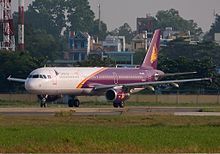
A Cambodia Angkor Air Airbus A321.
The nation’s extensive inland waterways were important historically in international trade. The Mekong and the Tonle Sap
River, their numerous tributaries, and the Tonle Sap provided avenues
of considerable length, including 3,700 kilometers (2,300 mi) navigable
all year by craft drawing 0.6 meters (2 ft) and another 282 kilometers
(175 mi) navigable to craft drawing 1.8 meters (6 ft).[109] Cambodia has two major ports, Phnom Penh and Sihanoukville, and five minor ones. Phnom Penh, located at the junction of the Bassac, the Mekong, and the Tonle Sap rivers, is the only river port capable of receiving 8,000-ton
ships during the wet season and 5,000-ton ships during the dry season.
With increasing economic activity has come an increase in automobile and
motorcycle use, though bicycles still predominate.[110] “Cyclo” (as hand-me-down French) or Cycle rickshaws
are an additional option often used by visitors. These kind of
rickshaws are unique to Cambodia in that the cyclist is situated behind
the passenger(s) seat,[111] as opposed to Cycle rickshaws in neighbouring countries where the cyclist is at the front and “pulls” the carriage.
The country has four commercial airports. Phnom Penh International Airport (Pochentong) in Phnom Penh is the second largest in Cambodia. Siem Reap-Angkor International Airport is the largest and serves the most international flights in and out of Cambodia. The other airports are in Sihanoukville and Battambang.
• Neak Pean
http://en.wikipedia.org/wiki/Neak_Pean
Neak Pean (Khmer: ប្រាសាទនាគព័ន្ធ) (”The entwined serpents”) at Angkor, Cambodia is an artificial island with a Buddhist temple on a circular island in Preah Khan Baray built during the reign of King Jayavarman VII. It is the “Mebon” of the Preah Khan baray (the “Jayatataka” of the inscription).[2]
Contents |
Etymology
The name is derived from the sculptures of snakes (Nāga) running around the base of the temple structure.
History
Some historians believe that Neak Pean represents Anavatapta, a mythical lake in the Himalayas whose waters are thought to cure all illness.[3]
Neak Pean was originally designed for medical purposes, as it is one of
the many hospitals that Jayavarman VII built. It is based on the
ancient Hindu belief of balance. Four connected pools represent Water,
Earth, Fire and Wind. The ancients believed that going into these pools
would balance the elements in the bather, thus curing disease. In the
middle of the four healing ponds is the central water source. There is a
statue of Balaha (Bodhisattva Guanyin transformed into a horse), as a symbol of drowning prevention.
• Preah Khan
http://en.wikipedia.org/wiki/Preah_Khan
article is about Preah Khan in Angkor, near Siem Reap. For Preah Khan
(of) Kompong Svay, in Preah Vinear province, 100 km (62 mi) at east of
Angkor, see Preah Khan Kompong Svay.
| Preah Khan | |
|---|---|
 |
|
|
|
|
| Coordinates: | 13.4619594°N 103.8715911°ECoordinates: 13.4619594°N 103.8715911°E |
| Name | |
| Proper name: | Preah Khan |
| Location | |
| Country: | Cambodia |
| Location: | Angkor |
| Architecture and culture | |
| Primary deity: | Avalokiteshvara |
| Architectural styles: | Khmer |
| History | |
| Date built: (Current structure) |
1191 A.D. |
| Creator: | Jayavarman VII |
Preah Khan (Khmer: ប្រាសាទព្រះខ័ន), sometimes transliterated as Prah Khan, is a temple at Angkor, Cambodia, built in the 12th century for King Jayavarman VII. It is located northeast of Angkor Thom and just west of the Jayatataka
baray, with which it was associated. It was the centre of a substantial
organisation, with almost 100,000 officials and servants. The temple is
flat in design, with a basic plan of successive rectangular galleries around a Buddhist sanctuary complicated by Hindu satellite temples and numerous later additions. Like the nearby Ta Prohm, Preah Khan has been left largely unrestored, with numerous trees and other vegetation growing among the ruins.
Contents |
History
Preah Khan was built on the site of Jayavarman VII’s victory over the invading Chams in 1191. Unusually the modern name, meaning “holy sword”, is derived from the meaning of the original—Nagara Jayasri (holy city of victory).[1] The site may previously have been occupied by the royal palaces of Yasovarman II and Tribhuvanadityavarman.[2] The temple’s foundation stela has provided considerable information about the history and administration of the site: the main image, of the bodhisattva Avalokiteśvara in the form of the king’s father, was dedicated in 1191 (the king’s mother had earlier been commemorated in the same way at Ta Prohm). 430 other deities also had shrines on the site, each of which received an allotment of food, clothing, perfume and even mosquito nets;[3] the temple’s wealth included gold, silver, gems, 112,300 pearls and a cow with gilded horns.[4]
The institution combined the roles of city, temple and Buddhist
university: there were 97,840 attendants and servants, including 1000
dancers[5] and 1000 teachers.[6]
The temple is still largely unrestored: the initial clearing was from 1927 to 1932, and partial anastylosis
was carried out in 1939. Since then free-standing statues have been
removed for safe-keeping, and there has been further consolidation and
restoration work. Throughout, the conservators have attempted to balance
restoration and maintenance of the wild condition in which the temple
was discovered: one of them, Maurice Glaize, wrote that;
The temple was previously overrun with a particularly voracious
vegetation and quite ruined, presenting only chaos. Clearing works were
undertaken with a constant respect for the large trees which give the
composition a pleasing presentation without constituting any immediate
danger. At the same time, some partial anastylosis has revived various
buildings found in a sufficient state of preservation and presenting
some special interest in their architecture or decoration.[7]
Since 1991, the site has been maintained by the World Monuments Fund.
It has continued the cautious approach to restoration, believing that
to go further would involve too much guesswork, and prefers to respect
the ruined nature of the temple. One of its former employees has said,
“We’re basically running a glorified maintenance program. We’re not
prepared to falsify history”.[8] It has therefore limited itself primarily to stabilisation work on the fourth eastern gopura, the House of Fire and the Hall of Dancers.[9]
The site
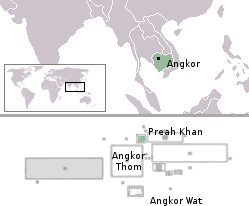

The fourth enclosure wall bears 5 m garudas holding nagas. Buddha images in the niches above were destroyed in the anti-Buddhist reaction of Jayavarman VIII.
The outer wall of Preah Khan is of laterite, and bears 72 garudas holding nagas, at 50 m intervals. Surrounded by a moat,
it measures 800 by 700 m and encloses an area of 56 hectares (140
acres). To the east of Preah Khan is a landing stage on the edge of the Jayatataka baray, now dry, which measured 3.5 by 0.9 km (2 by 1 mi). This also allowed access to the temple of Neak Pean
in the centre of the baray. As usual Preah Khan is oriented toward the
east, so this was the main entrance, but there are others at each of the
cardinal points. Each entrance has a causeway over the moat with nāga-carrying devas and asuras similar to those at Angkor Thom; Glaize considered this an indication that the city element of Preah Khan was more significant than those of Ta Prohm or Banteay Kdei.[10]
Halfway along the path leading to the third enclosure, on the north side, is a House of Fire (or Dharmasala)
similar to Ta Prohm’s. The remainder of the fourth enclosure, now
forested, was originally occupied by the city; as this was built of
perishable materials it has not survived. The third enclosure wall is
200 by 175 metres (660 by 574 ft). In front of the third gopura
is a cruciform terrace. The gopura itself is on a large scale, with
three towers in the centre and two flanking pavilions. Between the
southern two towers were two celebrated silk-cotton trees,
of which Glaize wrote, “resting on the vault itself of the gallery,
[they] frame its openings and brace the stones in substitute for pillars
in a caprice of nature that is as fantastic as it is perilous.”[11]
One of the trees is now dead, although the roots have been left in
place. The trees may need to be removed to prevent their damaging the
structure.[12] On the far side of the temple, the third western gopura has pediments of a chess game and the Battle of Lanka, and two guardian dvarapalas to the west.
West of the third eastern gopura, on the main axis is a Hall of Dancers. The walls are decorated with apsaras; Buddha images in niches above them were destroyed in the anti-Buddhist reaction under Jayavarman VIII.
North of the Hall of Dancers is a two-storeyed structure with round
columns. No other examples of this form survive at Angkor, although
there are traces of similar buildings at Ta Prohm and Banteay Kdei.
Freeman and Jacques speculate that this may have been a granary.[13]
Occupying the rest of the third enclosure are ponds (now dry) in each
corner, and satellite temples to the north, south and west. While the
main temple was Buddhist, these three are dedicated to Shiva, previous kings and queens, and Vishnu respectively. They are notable chiefly for their pediments: on the northern temple, Vishnu reclining to the west and the Hindu trinity of Vishnu, Shiva and Brahma to the east; on the western temple, Krishna raising Mount Govardhana to the west.[14]
Connecting the Hall of Dancers and the wall of the second enclosure is a courtyard containing two libraries.
The second eastern gopura projects into this courtyard; it is one of
the few Angkorian gopuras with significant internal decoration, with garudas on the corners of the cornices. Buddha images on the columns were changed into hermits under Jayavarman VIII.
Between the second enclosure wall (85 by 76 m or 279 by 249 ft) and
the first enclosure wall (62 by 55 m or 203 by 180 ft) on the eastern
side is a row of later additions which impede access and hide some of
the original decoration. The first enclosure is, as Glaize said,
similarly, “choked with more or less ruined buildings”.[15] The enclosure is divided into four parts by a cruciform gallery,
each part almost filled by these later irregular additions. The walls
of this gallery, and the interior of the central sanctuary, are covered
with holes for the fixing of bronze plates which would originally have
covered them and the outside of the sanctuary—1500 tonnes was used to
decorate the whole temple.[16] At the centre of the temple, in place of the original statue of Lokesvara, is a stupa built several centuries after the temple’s initial construction.
Photo gallery
-
Stupa with direct sunlight
• Preah Palilay
http://en.wikipedia.org/wiki/Preah_Palilay
Preah Palilay (Khmer: ប្រាសាទព្រះប៉ាលីឡៃ) is a temple at Angkor, Cambodia. It is located in Angkor Thom, 400 m north-west of Phimeanakas.
Contents |
History
The coexistence of Hindu and buddhist
elements and lacking of foundation stele or inscriptions make somewhat
difficult dating this temple. It is generally ascribed to Jayavarman VIII
reign, but it seems difficult to explain how the buddhist imageries
could have survive from the iconoclast fury of that epoch. Maybe it was
built in different periods: the sanctuary in the first half of 12th
century, while the gopura in the late 13th or early 14th century. The temple was cleaned by Henri Marchal in 1918-19, while the gopura was restored by anastylosis by Maurice Glaize in 1937-38.[1]
Description
The temple has a cross-shaped terrace, 8.5 m by 30 m long, with seven-headed nāga balaustrades in good conditions, on the east, guarded by two decapitated dvarapalas and a lion (of an original two). A 33 m-long causeway connects it to the single sandstone gopura.[2]
Before the laterite enclosure 50 m square there is a shrine with a 3 m
tall statue of Buddha, sitting on a lotus, of a later period.
The gopura has three entrances, the east-facing pediment of the
northern one shows “the offering of the animals in the forest of
Parilyyaka”, where the Buddha retreated after leaving Kosambi. It seems
that the origin of Pralilay could have been the alteration of the name Parilyyaka.[1] Even the other pediments shows exemplary scenes of Buddha.
The sandstone sanctuary stands on a three tiered basement, 6 m high
in overall. It has a 5 m square central chamber that opens to the four
cardinal points with as many vestibules. Their classical ornamentations,
unfortunately ruined, suggest that the sanctuary belongs to the first
half of the 12th century and is older than the gopura. Even the
characteristic “chimney-like” tower that stands above seems to be a
later addition, maybe a frame for a covering.
Some parts of the pediments have been taken away for safe-keeping, others lying on the ground. The visibile parts show Indra on his mount, the elephant Airavata, and the assault of the demoniac army of Mara.[3]
At the present time there is a little buddhist monastery near the
temple and the presence of the monks in its area is not uncommon.
• Ta Prohm
http://en.wikipedia.org/wiki/Ta_Prohm
Ta Prohm (Khmer: ប្រាសាទតាព្រហ្ម) is the modern name of a temple at Angkor, Siem Reap Province, Cambodia, built in the Bayon style largely in the late 12th and early 13th centuries and originally called Rajavihara (in Khmer: រាជវិហារ). Located approximately one kilometre east of Angkor Thom and on the southern edge of the East Baray, it was founded by the Khmer King Jayavarman VII as a Mahayana Buddhist
monastery and university. Unlike most Angkorian temples, Ta Prohm has
been left in much the same condition in which it was found: the
photogenic and atmospheric combination of trees growing out of the ruins
and the jungle surroundings have made it one of Angkor’s most popular temples with visitors.
Contents |
History of Ta Prohm
Foundation and expansion
After ascending the throne of Cambodia in 1181 A.D., Jayavarman VII
embarked on a massive program of construction and public works.
Rajavihara (”royal temple”), today known as Ta Prohm (”ancestor
Brahma”), was one of the first temples founded pursuant to that program.
The stele commemorating the foundation gives a date of 1186 A.D.[1]
Jayavarman VII constructed Rajavihara in honor of his family. The temple’s main image, representing Prajnaparamita,
the personification of wisdom, was modelled on the king’s mother. The
northern and southern satellite temples in the third enclosure were
dedicated to the king’s guru and his elder brother respectively. As
such, Ta Prohm formed a complementary pair with the temple monastery of Preah Khan, dedicated in 1191 A.D., the main image of which represented the Bodhisattva of compassion Lokesvara and was modelled on the king’s father.[2]
The temple’s stele
records that the site was home to more than 12,500 people (including 18
high priests and 615 dancers), with an additional 80,000 souls in the
surrounding villages working to provide services and supplies. The stele
also notes that the temple amassed considerable riches, including gold,
pearls and silks.[3] Expansions and additions to Ta Prohm continued as late as the rule of Srindravarman at the end of the 13th century.
Abandonment and restoration
After the fall of the Khmer empire
in the 15th century, the temple of Ta Prohm was abandoned and neglected
for centuries. When the effort to conserve and restore the temples of Angkor began in the early 20th century, the École française d’Extrême-Orient
decided that Ta Prohm would be left largely as it had been found, as a
“concession to the general taste for the picturesque.” According to
pioneering Angkor scholar Maurice Glaize,
Ta Prohm was singled out because it was “one of the most imposing
[temples] and the one which had best merged with the jungle, but not yet
to the point of becoming a part of it”.[4]
Nevertheless, much work has been done to stabilize the ruins, to permit
access, and to maintain “this condition of apparent neglect.”[2]
As of 2010, however, it seems Archaeological Survey of India has
undertaken a more aggressive approach to restoration. All the plants and
shrubs have been cleared from the site and some of trees are also
getting removed.[citation needed]
A crane has been erected and a large amount of building work is
underway to restore the temple, with much of the work seemingly just
rebuilding the temple from scratch as at other sites. Wooden walkways,
platforms, and roped railings have been put in place around the site
which now block some of the previously famous postcard photo
opportunities.[citation needed]
The site
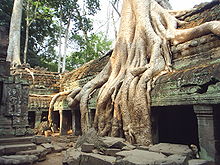
Roots of a spung running along the gallery of the second enclosure.
Layout
The design of Ta Prohm is that of a typical “flat” Khmer temple (as opposed to a temple-pyramid or temple-mountain, the inner levels of which are higher than the outer). Five rectangular enclosing walls surround a central sanctuary.
Like most Khmer temples, Ta Prohm is oriented to the east, so the
temple proper is set back to the west along an elongated east-west axis.
The outer wall of 1000 by 650 metres encloses an area of 650,000 square
metres that at one time would have been the site of a substantial town,
but that is now largely forested. There are entrance gopuras at each of the cardinal points,
although access today is now only possible from the east and west. In
the 13th century, face towers similar to those found at the Bayon
were added to the gopuras. Some of the face towers have collapsed. At
one time, moats could be found inside and outside the fourth enclosure.
The three inner enclosures of the temple proper are galleried, while the corner towers of the first enclosure form a quincunx
with the tower of the central sanctuary. This basic plan is complicated
for the visitor by the circuitous access necessitated by the temple’s
partially collapsed state, as well as by the large number of other
buildings dotting the site, some of which represent later additions. The
most substantial of these other buildings are the libraries
in the southeast corners of the first and third enclosures; the
satellite temples on the north and south sides of the third enclosure;
the Hall of Dancers between the third and fourth eastern gopuras; and a House of Fire east of the fourth eastern gopura.
Representational art
Ta Prohm has not many narrative bas-reliefs(compared
to Angkor Wat or Angkor Thom). One explanation that has been proffered
for this dearth is that much of the temple’s original Buddhist narrative
artwork must have been destroyed by Hindu iconoclasts following the
death of Jayavarman VII. At any rate, some depictions of scenes from
Buddhist mythology do remain. One badly eroded bas-relief illustrates
the “Great Departure” of Siddhartha, the future Buddha, from his father’s palace.[5] The temple also features stone reliefs of devatas (minor female deities), meditating monks or ascetics, and dvarapalas or temple guardians.
Trees
The trees growing out of the ruins are perhaps the most distinctive
feature of Ta Prohm, and “have prompted more writers to descriptive
excess than any other feature of Angkor.”[2] Two species predominate, but sources disagree on their identification: the larger is either the silk-cotton tree (Ceiba pentandra) or thitpok Tetrameles nudiflora,[6] and the smaller is either the strangler fig (Ficus gibbosa).[7] or Gold Apple (Diospyros decandra).[6] Indulging in what might be regarded as “descriptive excess,” Angkor scholar Maurice Glaize
observed, “On every side, in fantastic over-scale, the trunks of the
silk-cotton trees soar skywards under a shadowy green canopy, their long
spreading skirts trailing the ground and their endless roots coiling
more like reptiles than plants.”[8]
In popular media
The temple of Ta Prohm was used as a location in the film Tomb Raider. Although the film took visual liberties with other Angkorian temples, its scenes of Ta Prohm were quite faithful to the temple’s actual appearance, and made use of its eerie qualities.[citation needed]
Some believe that one of the carvings resembles a stegosaurus.[9]
• Ta Som
http://en.wikipedia.org/wiki/Ta_Som
Ta Som (Khmer: ប្រាសាទតាសោម) is a small temple at Angkor, Cambodia, built at the end of the 12th century for King Jayavarman VII. It is located north east of Angkor Thom and just east of Neak Pean. The King dedicated the temple to his father Dharanindravarman II (Paramanishkalapada) who was King of the Khmer Empire from 1150 to 1160. The temple consists of a single shrine located on one level and surrounded by enclosure laterite walls. Like the nearby Preah Khan and Ta Prohm the temple was left largely unrestored, with numerous trees and other vegetation growing among the ruins.[1] In 1998, the World Monuments Fund (WMF) added the temple to their restoration program and began work to stabilise the structure to make it safer for visitors.[2]
Contents |
Structure
Designed to be entered from the east, Ta Som is surrounded by a moat and enclosed by three laterite walls which are broken by two sets of gopura (entrance ways). The gopuras are cross-shaped and contain a small room on each side along with windows containing balusters. The main structure of the gopura are carved with four faces in the Bayon style.[1] The eastern outer gopura has been overgrown by a sacred fig (Ficus religiosa) which has grown down through the blocks that make up the gopura and into the ground.[3] The inner section of the temple consists of a central cruciform sanctuary with porches at each arm surrounded by four corner pavilions. Two small libraries sit on either side of the eastern entrance path.[1]
Restoration
According to the APSARA Authority who manage the temples in the Angkor
Park, little restoration work had been done at Ta Som until the 1950s.
At this time some propping of structures that were near collapse was
carried out. After the WMF added Ta Som to their project, the WMF team
began to document and interpret the site and carry out emergency
stabilization of fragile structures and improvement to visitor flow
around the monument.[4]
In 2007, WMF and the APSARA Authority conducted clearing and
documentation works that allowed the temple to be accessed from all four
sides. Many sandstone blocks were repaired and this allowed the
reconstruction of the North Central Fronton of the North Gopura.[5]
Gallery
Wat Preah Keo Morokot
Kampong Thom
• Prasat Kuh Nokor
http://en.wikipedia.org/wiki/Prasat_Kuh_Nokor
Prasat Kuh Nokor is a Buddhist temple in the village of Trodoc Poung, Pong Ror commune, in Baray District, in Kampong Thom Province, Cambodia. It was built in 10th -11th century by the king Suryavarman I (1002-1050). It is part of the pagoda Wat Kuh Nokor.
It was built on a square shaped courtyard consisting of laterite and sandstone
facing east. The throne is also square decorated by lotus flowers with
several male statues. One of the statues is known to locals as the ‘Neak
Ta Bark Kor’. [1]
The temple is known also for its two ponds temple. The largest is 160 metres long and 88 metres wide. The smaller of the two is 45 metres in length and 20 metres wide.[2]
Phnom Penh
• Wat Botum
http://en.wikipedia.org/wiki/Wat_Botum
| Wat Botum Vathey | |
|---|---|
 |
|
| The facade of Wat Botum | |
| Information | |
| Denomination | Theravada Buddhism (Thammayut sector) |
| Founded | 1442 |
| Founder(s) | King Ponhea Yat |
| Country | Cambodia |
Wat Botum Vathey (Khmer: វត្តបុទម, lit. Temple of the Lotus Blossoms) is a wat located at Oknha Suor Srun Street 7, Sangkat Chaktomuk, Khan Daun Penh, Phnom Penh, Cambodia. It is located to the south of the Royal Palace of Cambodia, on the western side of Wat Botum Park.[1]
History
Established by King Ponhea Yat in 1442 (1986 B.E.), Wat Botum is one of the most important and original pagodas in Phnom Penh.The wat was originally named Wat Khpop Ta Yang or Wat Tayawng and at the time of the construction of the Royal Palace in the 1860s when the pagoda changed to the Dhammayut sect, it was renamed Botum Wathei by monk Kantie Topodae after a former lotus pond on the site.[2][3] Numerous politician and eminent persons of the city are buried here.[4] Also, many prominent Cambodian monks have been ordained at the wat. You Bo and the Khmer Writers’ Association have their headquarters at the wat.
• Wat Ounalom
http://en.wikipedia.org/wiki/Wat_Ounalom
Wat Ounalom also pronounce Wat Onalaom is a wat located on Sisowath Quay in Phnom Penh, Cambodia, near the Royal Palace of Cambodia.[1]It
is the most important wat of Phnom Penh, and the center of Cambodian
Buddhism. It was established in 1443 and consists of 44 structures.[2][2] It was damaged during the Khmer Rouge but has since been restored.[2] The main complex has a stupa which contains what is believed to be an eyebrow hair of Buddha and an inscription in Pali.[2]
| This article about a building or structure in Cambodia is a stub. You can help Wikipedia by expanding it. |
| This article about a Buddhist monastery, temple or nunnery is a stub. You can help Wikipedia by expanding it. |
• Wat Phnom
http://en.wikipedia.org/wiki/Wat_Phnom
Wat Phnom (Khmer: វត្តភ្នំ) (”Temple of the Mountains” or “Mountain Pagoda”) is a Buddhist temple (wat) located in Phnom Penh, Cambodia. It was built in 1373, and stands 27 metres above the ground. It is the tallest religious structure in the city.
Contents |
History
Legend relates that Daun Penh, a wealthy widow, found a large koki
tree in the river. Inside the tree she found four bronze statues of the Buddha.
Lady Penh constructed a small shrine on an artificial hill to protect
the sacred statues. Eventually this became a sacred site and sanctuary
where people would make blessings and pray.
Another account of the founding of the wat suggests King Ponhea Yat, built the sanctuary (vihear) when he moved his capital from Angkor
to Phnom Penh in 1422. The prominent stupa immediately west of the
sanctuary contains the ashes of the king and his royal family.
Wat Phnom is the center of celebration during Khmer New Year, and Pchum Ben.
Architecture
The sanctuary itself was rebuilt several times in the 19th century
and again in 1926. The interior has a central altar complex with a large
bronze seated Buddha surrounded by other statues, flowers, candles and
items of devotion and worship. The walls are covered with murals,
especially of Jataka stories of the Buddha’s earlier reincarnations
before his enlightenment. There are also murals depicting stories from the Reamker, the Khmer version of the Ramayana. The newer murals in the bottom tiers are somewhat balanced, traditional and modern.
The southwest corner of the vihear and stupa, is a small shrine dedicated to Lady Penh.
The front is often crowded with the faithful bringing their prayers and
food offerings to the woman deemed responsible for the founding of the
wat.
• Wat Preah Keo (Silver Pagoda)
http://en.wikipedia.org/wiki/Silver_Pagoda,_Phnom_Penh
The Silver Pagoda is located on the south side of the Royal Palace, Phnom Penh. Formerly, it was known as Wat Ubosoth Ratanaram. The temple’s official name is Preah Vihear Preah Keo Morakot but is commonly referred to as Wat Preah Keo in Khmer.
The vihara
houses many national treasures such as gold and jeweled Buddha statues.
Most notable is a small 17th century baccarat crystal Buddha (the
“Emerald Buddha” of Cambodia) and a life-sized gold Maitreya Buddha
decorated with 9584 diamonds, the largest of which weighs 25 carats. It
was created in the palace workshops during 1906 and 1907, the gold
Buddha weighs in at 90kg and is dressed in royal regalia commissioned by
King Sisowath. During King Norodom Sihanouk’s pre-Khmer Rouge
reign, the Silver Pagoda was inlaid with more than 5,000 silver tiles
and some of its outer facade was remodelled with Italian marble. However
only a small area of these tiles are available to be viewed by the
public on entering the pagoda.
It is a notable wat (Buddhist temple) in Phnom Penh and the official temple of the King of Cambodia.
Gallery
-
The Emerald Buddha
-
Stupa of King Norodom Suramarit
-
Inside the vihara
-
A decorative column figurine (Kinnara)
Pursat
• Wat Bakan
http://en.wikipedia.org/wiki/Wat_Bakan
Wat Bakan or Bakan Pagoda (Khmer: វត្តបាកាន) is a pagoda in Bakan District of Pursat Province in Cambodia. It is one of the oldest active pagodas in the country.
The Buddhist Institute of Cambodia notes that the original pagoda is
over 800 years old and has been in continuous use as a temple. It is
regarded as one of the holiest sites in Cambodian Buddhism.[1] Parts of the original pagoda can still be seen around a small mound behind the vihear of the main temple. During the Khmer Rouge years, many stones from the old temple were taken to build an embankment and repair bridges at Damnak Ampil nearby.[2]
| This article about a building or structure in Cambodia is a stub. You can help Wikipedia by expanding it. |
| This article about a Buddhist monastery, temple or nunnery is a stub. You can help Wikipedia by expanding it. |
THE FOOLHARDY WOLF
[60]
| A |
LION bounded forth from his lair one day,
looking north, west, south, and east.
He saw a Buffalo and went to kill him.
The Lion ate all of the Buffalo-meat he wanted,
and then went down to the lake for a drink.
As the Lion turned to go toward his den for a nap,
he came upon a hungry Wolf.
The Wolf had no chance to get away,
so he threw himself at the Lion’s feet.
“What do you want?” the Lion asked.
“O Lion, let me be your servant,” said the Wolf.
“Very well,” said the Lion, “serve me,
and you shall have good food to eat.”
So saying, the Lion went into his den for his nap.
When he woke up, the Lion said to the Wolf:
“Each day you must go to the mountain top,
and see whether there are any elephants,
or ponies, or buffaloes about. If you see any,
[61] come to me and say: ‘Great Lion, come forth in thy might.
Food is in sight.’ Then I will kill and eat,
and give part of the meat to you.”
So day after day the Wolf climbed to the mountain top,
and seeing a pony, or a buffalo, or an elephant,
he went back to the den, and falling at the Lion’s feet he said:
“Great Lion, come forth in thy might. Food is in sight.”
![[Illustration]](http://www.mainlesson.com/books/babbitt/morejataka/zpage061.gif)
Then the Lion would bound forth and kill whichever beast it was,
sharing the meat with the Wolf.
Now this Wolf had never had such fine meat to eat,
nor so much. So as time went on, the Wolf grew bigger and bigger,
and stronger and stronger, until he was really proud
of his great size and strength.
“See how big and strong I am,” he said to himself.
[62] “Why am I living day after day on food given me by another?
I will kill for my own eating. I’ll kill an elephant for myself.”
So the Wolf went to the Lion, and said:
“I want to eat an elephant of my own killing.
Will you let me lie in your corner in the den,
while you climb the mountain to look out for an elephant?
Then when you see one, you come to the den and say,
‘Great Wolf, come forth in thy might. Food is in sight.’
Then I will kill the elephant.”
Said the Lion: “Wolf, only Lions can kill elephants.
The world has never seen a Wolf that could kill an elephant.
Give up this notion of yours, and eat what I kill.”
But no matter what the Lion said, the Wolf would not give way.
So at last the Lion said: “Well, have your own way.
Lie down in the den, and I will climb to the top of the mountain.”
![[Illustration]](http://www.mainlesson.com/books/babbitt/morejataka/zpage063.gif)
When he saw an elephant the Lion went back to the mouth of the cave,
and said: “Great Wolf, come forth in thy might. Food is in sight.”
Then from the den the Wolf nimbly bounded forth,
ran to where the elephant was, and, howling three times,
he sprang at the elephant.
But the Wolf missed his aim, and fell down at the elephant’s
[64] feet.
The elephant raised his right foot and killed the Wolf.
Seeing all this, the Lion said, “You will no more come forth
in your might, you foolhardy Wolf.”
http://en.wikipedia.org/wiki/Culture_of_Cambodia
.
Throughout Cambodia’s
long history, religion has been a major source of cultural inspiration.
Over nearly two millennia, Cambodians have developed a unique Khmer belief from the syncreticism of indigenous animistic beliefs and the Indian religions of Buddhism and Hinduism. Indian culture and civilization, including its languages and arts reached mainland Southeast Asia
around the 1st century AD. It is generally believed that seafaring
merchants brought Indian customs and culture to ports along the Gulf of Thailand and the Pacific en route to trade with China. The Kingdom of Funan was most probably the first Khmer state to benefit from this influx of Indian ideas.
Contents |
History
The golden age of Cambodia was between the 9th and 14th century, during the Angkor period, during which it was a powerful and prosperous empire that flourished and dominated almost all of inland Southeast Asia.
However, Angkor would eventually collapse after much in-fighting
between royalty and constant warring with its increasingly powerful
neighbors, notably Siam and Dai Viet. Many temples from this period however, like Bayon and Angkor Wat still remain today, scattered throughout Thailand, Cambodia, Laos, and Vietnam as a reminder of the grandeur of Khmer arts and culture. Cambodia’s unparalleled achievements in art, architectures, music, and dance during this period have had a great influence on many neighboring kingdoms, namely Thailand and Laos.
The effect of Angkorian culture can still be seen today in those
countries, as they share many close characteristics with current-day
Cambodia.
Architecture and housing
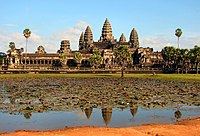
Angkor Wat, the most famous Cambodian heritage site.

The Royal Palace in Phnom Penh

Rural style house in Cambodia
The Angkorian architects and sculptors
created temples that mapped the cosmic world in stone. Khmer
decorations drew inspiration from religion, and mythical creatures from Hinduism and Buddhism
were carved on walls. Temples were built in accordance to the rule of
ancient Khmer architecture that dictated that a basic temple layout
include a central shrine, a courtyard, an enclosing wall, and a moat.
Khmer motifs use many creatures from Buddhist and Hindu mythology, like
the Royal Palace in Phnom Penh, use motifs such as the garuda, a mythical bird in Hinduism. The architecture of Cambodia developed in stages under the Khmer empire from the 9th to the 15th century, preserved in many buildings of the Angkor
temple. The remains of secular architecture from this time are rare, as
only religious buildings were made of stone. The architecture of the
Angkor period used specific structural features and styles, which are
one of the main methods used to date the temples, along with
inscriptions.
In modern rural Cambodia, the nuclear family typically lives in a rectangular house
that may vary in size from four by six meters to six by ten meters. It
is constructed of a wooden frame with gabled thatch roof and walls of
woven bamboo. Khmer houses are typically raised as much as three meters on stilts for protection from annual floods. Two ladders or wooden staircases provide access to the house. The steep thatch roof overhanging the house walls protects the interior
from rain. Typically a house contains three rooms separated by
partitions of woven bamboo. The front room serves as a living room used
to receive visitors, the next room is the parents’ bedroom, and the
third is for unmarried daughters. Sons sleep anywhere they can find
space. Family members and neighbors work together to build the house,
and a house-raising ceremony is held upon its completion. The houses of
poorer persons may contain only a single large room. Food is prepared in
a separate kitchen located near the house but usually behind it. Toilet facilities consist of simple pits in the ground, located
away from the house, that are covered up when filled. Any livestock is
kept below the house. Chinese and Vietnamese houses in Cambodian towns
and villages are typically built directly on the ground and have
earthen, cement, or tile floors, depending upon the economic status of
the owner. Urban housing and commercial buildings may be of brick,
masonry, or wood.[2]
Religion
Cambodia is predominantly Buddhist with 90% of the population being Theravada Buddhist, 1% Christian and the majority of the remaining population follow Islam, atheism, or animism.

Buddhist nun at Angkor Wat, Siem Reap, Cambodia.
Buddhism has existed in Cambodia since at least the 5th century CE Theravada
Buddhism has been the Cambodian state religion since the 13th century
CE (excepting the Khmer Rouge period), and is currently estimated to be
the faith of 90% of the population.[3]

Buddhist monks at Angkor Wat. Buddhism is the official religion in all of Cambodia.
Islam is the religion of a majority of the Cham (also called Khmer Islam) and Malay minorities in Cambodia. According to Po Dharma, there were 150,000 to 200,000 Muslims in Cambodia as late as 1975. Persecution under the Khmer Rouge
eroded their numbers, however, and by the late 1980s they probably had
not regained their former strength. All of the Cham Muslims are Sunnis of the Shafi’i school. Po Dharma divides the Muslim Cham in Cambodia into a traditionalist branch and an orthodox branch.
Christianity
was introduced into Cambodia by Roman Catholic missionaries in 1660.
However, it made little headway at first, particularly among Buddhists.
In 1972 there were probably about 20,000 Christians in Cambodia, most of
whom were Roman Catholics. According to Vatican
statistics, in 1953, members of the Roman Catholic Church in Cambodia
numbered 120,000, making it, at that time, the second largest religion
in the country. In April 1970, just before repatriation, estimates
indicate that about 50,000 Catholics were Vietnamese. Many of the
Catholics remaining in Cambodia in 1972 were Europeans—chiefly French.
American Protestant missionary activity increased in Cambodia,
especially among some of the hill tribes and among the Cham, after the
establishment of the Khmer Republic. The 1962 census, which reported
2,000 Protestants
in Cambodia, remains the most recent statistic for the group. Observers
reported that in 1980 there were more registered Khmer Christians among
the refugees in camps in Thailand than in all of Cambodia before 1970.
Kiernan notes that, until June 1980, five weekly Protestant services
were held in Phnom Penh by a Khmer pastor, but that they had been
reduced to a single weekly service after police harassment.[2]
There are around 20,000 Catholics in Cambodia which represents only
0.15% of the total population. There are no dioceses, but there are
three territorial jurisdictions - one Apostolic Vicariate and two Apostolic Prefectures.
Highland tribal groups, most with their own local religious systems, probably number fewer than 100,000 persons. The Khmer Loeu have been loosely described as animists,
but most tribal groups have their own pantheon of local spirits. In
general they see their world filled with various invisible spirits
(often called yang), some benevolent, others malevolent. They associate
spirits with rice, soil, water, fire, stones, paths, and so forth.
Sorcerers or specialists in each village contact these spirits and
prescribe ways to appease them. In times of crisis or change, animal
sacrifices may be made to placate the anger of the spirits. Illness is
often believed to be caused by evil spirits or sorcerers. Some tribes
have special medicine men or shamans
who treat the sick. In addition to belief in spirits, villagers believe
in taboos on many objects or practices. Among the Khmer Loeu, the Rhade and Jarai groups have a well-developed hierarchy of spirits with a supreme ruler at its head.[2]
Ways of life
Birth and death rituals
The birth of a child is a happy event for the family. According to
traditional beliefs, however, confinement and childbirth expose the
family, and especially the mother and the child to harm from the spirit
world. A woman who dies in childbirth—crosses the river (chhlong tonle)
in Khmer is believed to become an evil spirit. In traditional Khmer
society, a pregnant woman respects a number of food taboos and avoids
certain situations. These traditions remain in practice in rural
Cambodia, but they have become weakened in urban areas.[4]
Death is not viewed with the great outpouring of grief common to
Western society; it is viewed as the end of one life and as the
beginning of another life that one hopes will be better. Buddhist Khmer
usually are cremated, and their ashes are deposited in a stupa in the
temple compound. A corpse is washed, dressed, and placed in a coffin,
which may be decorated with flowers and with a photograph of the
deceased. White pennant-shaped flags, called “white crocodile flags,”
outside a house indicate that someone in that household has died. A
funeral procession consisting of an achar,
Buddhist monks, members of the family, and other mourners accompanies
the coffin to the crematorium. The spouse and the children show mourning
by shaving their heads and by wearing white clothing. Relics such as
teeth or pieces of bone are prized by the survivors, and they are often
worn on gold chains as amulets.[4] If the child is always ill, his or her parents can go and change the name of child
Childhood and adolescence
A Cambodian child may be nursed until two to four years of age. Up to
the age of three or four, the child is given considerable physical
affection and freedom. Children around five years of age also may be
expected to help look after younger siblings. Children’s games emphasize
socialization or skill rather than winning and losing.[4]
Most children begin school when they are seven or eight. By the time
they reach this age, they are familiar with the society’s norms of
politeness, obedience, and respect toward their elders and toward
Buddhist monks. The father at this time begins his permanent retreat
into a relatively remote, authoritarian role. By age ten, a girl is
expected to help her mother in basic household tasks; a boy knows how to
care for the family’s livestock and can do farm work under the
supervision of older males. Adolescent children usually play with
members of the same sex. During his teens, a boy may become a temple
servant and go on to serve a time as a novice monk, which is a great
honor for the parents.[4]
In precommunist days, parents exerted complete authority over their
children until the children were married, and the parents continued to
maintain some control well into the marriage. Age difference is strictly
recognized with polite vocabulary and special generational terms for
“you”.[4]
Courtship, marriage, and divorce
In Cambodia, premarital sex is deplored. The choice of a spouse is a
complex one for the young male, and it may involve not only his parents
and his friends, as well as those of the young woman, but also a
matchmaker and a Haora.
In theory, a girl may veto the spouse her parents have chosen.
Courtship patterns differ between rural and urban Khmer; romantic love
is a notion that exists to a much greater extent in larger cities. A man
usually marries between the ages of nineteen and twenty-five, a girl
between the ages of sixteen and twenty-two. After a spouse has been
selected, each family investigates the other to make sure its child is
marrying into a good family. In rural areas, there is a form of
bride-service; that is, the young man may take a vow to serve his
prospective father-in-law for a period of time.
The traditional wedding is a long and colorful affair. Formerly it
lasted three days, but in the 1980s it more commonly lasted a day and a
half. Buddhist priests offer a short sermon and recite prayers of
blessing. Parts of the ceremony involve ritual hair cutting, tying
cotton threads soaked in holy water around the bride’s and groom’s
wrists, and passing a candle around a circle of happily married and
respected couples to bless the union. After the wedding, a banquet is
held. Newlyweds traditionally move in with the wife’s parents and may
live with them up to a year, until they can build a new house nearby.[4]
Divorce is legal and relatively easy to obtain, but not common.[4]
Divorced persons are viewed with some disapproval. Each spouse retains
whatever property he or she brought into the marriage, and
jointly-acquired property is divided equally. Divorced persons may
remarry, but the woman must wait ten months. Custody of minor children
is usually given to the mother, and both parents continue to have an
obligation to contribute financially toward the rearing and education of
the child.[4] The divorced male doesn’t have a waiting period before he can re-marry.[5]
Social organization
Khmer culture is very hierarchical.
The greater a person’s age, the greater the level of respect that must
be granted to them. Cambodians are addressed with a hierarchical title
corresponding to their seniority before the name. When a married couple
becomes too old to support themselves, they may invite the youngest
child’s family to move in and to take over running the household. At
this stage in their lives, they enjoy a position of high status.[4]
The individual Khmer is surrounded by a small inner circle of family
and friends who constitute his or her closest associates, those he would
approach first for help. The nuclear family, consisting of a husband
and a wife and their unmarried children, is the most important kin
group. Within this unit are the strongest emotional ties, the assurance
of aid in the event of trouble, economic cooperation in labor, sharing
of produce and income, and contribution as a unit to ceremonial
obligations. In rural communities, neighbors—who are often also kin—may
be important, too. Fictive child-parent, sibling, and close friend
relationships Cambodia transcend kinship boundaries and serve to
strengthen interpersonal and interfamily ties. Beyond this close circle
are more distant relatives and casual friends. In rural Cambodia, the
strongest ties a Khmer may develop—besides those to the nuclear family
and to close friends—are those to other members of the local community. A
strong feeling of pride—for the village, for the district, and
province—usually characterizes Cambodian community life.[6]
Legally, the husband is the head of the Khmer family, but the wife
has considerable authority, especially in family economics. The husband
is responsible for providing shelter and food for his family; the wife
is generally in charge of the family budget, and she serves as the major
ethical and religious model for the children, especially the daughters.
Both husbands and wives are responsible for domestic economic tasks.[6]
Customs
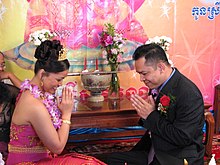
Sampeah (Cambodian greeting)
In Khmer culture a person’s head is believed to contain the person’s soul–therefore making it taboo
to touch or point one’s feet at it. It is also considered to be
extremely disrespectful to use the feet to point out a person, or to sit
or sleep with the soles of the feet pointing at a person, as the feet
are the lowest part of the body and are considered to be impure.
When greeting people or to show respect in Cambodia people do the “sampeah” gesture, identical to the Indian namaste and Thai wai.
Customary Cambodian teachings are laid out in verse form in long works from the 14th to 18th centuries collectively called Chhbap (”rules” or “codes”).[7] These were traditionally learned by rote. Works such as the Chhbap Pros (”Boy’s Code”), Chhbap Srey (”Girl’s Code”) and Chhbap Peak Chas
(”Code of Ancient Words”) gave such advice as: a person that does not
wake up before sunrise is lazy; a child must tell parents or elders
where they go and what time they will return home; always close doors
gently, otherwise a bad temper will be assumed; sit in a chair with the
legs straight down and not crossed (crossing the legs is a mark of an
impolite person); and always let the other person do more talking.
In Cambodia it is not polite to make eye contact with someone who is older or someone who is considered a superior.
Clothing
Clothing in Cambodia is one of the most important aspects of the
culture. Cambodian fashion differs according to ethnic group and social
class. Khmer people traditionally wear a checkered scarf called a Krama.
The “krama” is what distinctly separates the Khmer (Cambodians) from
their neighbors the Thai, the Vietnamese, and the Laotians. The scarf is
used for many purposes including for style, protection from the sun, an
aid (for the feet) when climbing trees, a hammock for infants, a towel, or as a “sarong“. A “krama” can also be easily shaped into a small child’s doll for play. Under the Khmer Rouge, krama of various patterns were part of standard clothing.

A Khmer women wearing a Krama
The long-popular traditional garment known as the Sampot, is an Indian-influenced costume which Cambodians have worn since the Funan era. Historically, Khmer clothing has changed depending on the time period and religion. From the Funan era to the Angkor Era, there was a strong Hindu influence in Cambodian fashion which favored wearing Sampots over the lower body and oftentimes nothing from the waist up except jewelry including bracelets and collars such as the Sarong Kor, a symbol of Hinduism.

A dancer wearing Sampot Chong Kben
As Buddhism began to replace Hinduism, Khmer people started wearing the blouse, shirt and trousers
of Khmer style. Khmer people, both common and royal, stopped wearing
the Hindu-style collars and began to adopt beautiful decorated shawls
such as Sbai instead. This new clothing style was popular in the Udong period.
In fact, a Khmer lady habitually chooses the right colour for her Sampot or blouse, both to please herself and to follow the costume of good luck.
Some Cambodians still wear a religious style of clothing. Some Khmer
men and women wear a Buddha pendant on a necklace. There are different
pendants for different uses; some are meant for protection from evil
spirits, some are meant to bring good luck.
Otherwise, in the notable class people in Cambodia, especially the
royal caste, have adapted a well known dress as well as expensive
fashion style.Sampot is still well recognized among the royalty. Most royalty prefer Sampot Phamuong, a new version of sampot adapted by Thai people
in the 17th century. Since the Udong period, most royalty have retained
their dressing habits. Female royalty created the most attractive
fashion. The lady always wears a traditional cape called sbai or rabai kanorng,
which is draped over the left shoulder, leaving the right shoulder
bare. Rarely was the cape worn over the right shoulder. The sbai or
rabai kanorng would have been sumptuously fashioned in the old days in
threads of genuine gold or silver. The cape in the old days would have
hung down to the hem of the Sampot.
Dancers wear a collar known as Sarong Kor around their necks. Importantly, they wear a unique skirt called Sampot sara-bhap
(lamé), made from silk inter-woven with gold or silver threads, forming
elaborate and intricate designs that shimmer as the dancers move. This
is held in place with a bejewelled belt. A multitude of jewellery is
also worn by the female dancers. These include earrings, several pairs
of bangles, a garland of flowers in the form of a bracelet, bracelets,
anklets and an armlet that is worn on the right. Several body chains
cross over the body like a sash. A circular or diamond shaped pendant is
worn around the neck.
There are several different types of mokot worn by female royalty.
The typical mokots that are worn are much similar to those of male
royalty. Some crowns are just like tiaras where at the back of the mokot
hair is let loose, cascading down the back. Other mokots have a few
accessories such as ear pieces that would sit above the ear and help
hold the mokot in place while a comb at the back is just an added
accessory. Flowers are also worn on the mokot in the same style, but the
hanging garlands of flowers are worn on the left and the bouquet is
worn on the right. The best example of these royal clothes is
illustrated by Khmer classical dance costumes, which are an adaptation
of the beautiful royalty costume.
Cuisine

Amok, a popular Cambodian dish

Fried Prahok
Khmer cuisine is similar to that of its Southeast Asian neighbors. It shares many similarities with Thai cuisine, Vietnamese cuisine and Teochew cuisine. Cambodian cuisine also uses fish sauce in soups, stir-fried cuisine, and as dippings. The Chinese influence can be noted in the common chha (Khmer: ឆារ, Stir frying) and in the use of many variations of rice noodles. A particular popular dish of ultimately Chinese origin is “pork broth rice noodle soup”, similar to phở, called kuy tieu (Khmer: គុយទាវ). Indian influenced dishes include many types of curry known as kari (Khmer: ការី)
that call for dried spices such as star anise, cardamom, cinnamon,
nutmeg and fennel as well as local ingredients like lemongrass, garlic,
kaffir lime leaves, shallots and galangal that give dishes a distinctive
Cambodian flavor.[8] Banh Chaew (Khmer: នំបាញ់ឆែវ), the Khmer version of the Vietnamese Bánh xèo, is also a popular dish.
Khmer cuisine is noted for the use of prahok (ប្រហុក), a type of fermented fish paste, in many dishes as a distinctive flavoring. When prahok is not used, it is likely to be kapǐ (កាពិ) instead, a kind of fermented shrimp paste. Coconut milk is the main ingredient of many Khmer curries and desserts. Cambodians prefer either jasmine rice or sticky (glutinous) rice. The latter is used more in dessert dishes with fruits such as durian
while jasmine rice is eaten with meals. Almost every meal is eaten with
a bowl of rice. Typically, Cambodians eat their meals with at least
three or four separate dishes. Each individual dish will usually be one
of either sweet, sour, salty or bitter. Chili is usually left up to the
individual to add themselves. In this way Cambodians ensure that they
get a bit of every flavor to satisfy their palates.
Regional Cambodian cuisine offers some unique dishes influenced by the traditions of local ethnic groups. In Kampot and Kep, known for its Kampot Pepper Crab or Kdam Chha Mrich Kchei (Khmer: ក្តាមឆាម្រេចខ្ជី) in Khmer. This dish is prepared with a local crab fried with the black pepper from area pepper fields. Kula people, an ethnic group of Pailin Province, originated Mee Kola (Khmer: មីកុឡា), a vegetarian rice stick noodle dish. In southeastern Cambodia, the influence of Vietnamese cuisine are strong, evidenced by Bánh tráng which is ubiquitous in southeastern Cambodia but virtually unknown elsewhere. The region between Siem Reap and Kampong Thom, an area with many Chinese Cambodians, displays Khmer versions of many Chinese dishes.
Arts and literature
Visual arts
The history of visual arts in Cambodia stretches back centuries to ancient crafts; Khmer art reached its peak during the Angkor period. Traditional Cambodian arts and crafts include textiles, non-textile weaving, silversmithing, stone carving, lacquerware, ceramics, wat murals, and kite-making.
Beginning in the mid-20th century, a tradition of modern art began in
Cambodia, though in the later 20th century both traditional and modern
arts declined for several reasons, including the killing of artists by
the Khmer Rouge. The country has experienced a recent artistic revival due to increased support from governments, NGOs, and foreign tourists.

Thon-rammana widely used in Khmer classical dance.
Music
Especially in the 60s and 70s, the ‘big two’ duet of Sinn Sisamouth and Ros Sereysothea
had been a large hit in the country. However after their deaths, new
music stars have tried to bring back the music. Cambodian music has
undergone heavy Westernization.
The Cambodian pinpeat ensemble is traditionally heard on feast days
in the pagodas. It is also a court ensemble used to accompany classical
dance for ritual occasions or theatrical events. The pinpeat is
primarily made up of percussion instruments: the roneat ek (lead
xylophone), roneat thung (low bamboo xylophone), kong vong touch and
kong vong thom (small and large sets of tuned gongs), sampho (two-sided
drum), skor thom (two large drums), and sralai (quadruple-reed
instrument).
Dance
Cambodian Dance can be divided into three main categories: classical dance, folk dances, and vernacular dances.

Princess Bopha Devi is noted as one of the most popular dancers in the country.
Khmer classical dance is a form of Cambodian dance originally
performed only for royalty. The dances have many elements in common with
Thai classical dance.
During the mid-20th century, it was introduced to the public where it
now remains a celebrated icon of Khmer culture, often being performed
during public events, holidays, and for tourists visiting Cambodia.this
classical Dance is famous for its using of hands and feet to express
emotion which known as there are 4,000 different gestures in this type
of dance. Provided as repeating a golden age in 1960s, Khmer Classical Dance which know as The Royal Ballet of Cambodia after select as UNESCO’s Masterpieces of the Oral and Intangible Heritage of Humanity, has lead one of its dance to be a outstanding dance of all for culture and society. Reamker, a khmer version of Indian, Ramayana had influced strongly to Khmer classical dance. It involved in khmer gesture, movement and story line.The dance that divided from Reamker Dance known as Robam Sovann Macha and Robam Moni Mekala. In Facts, all of Dance reminded the audience of celestial dance which is an angel or Apsara
in sansrit mythology in goal of bring the good luck and success to the
viewer. The Classical dance is create by the heart of high art as the
performer is decorated with themselves with a branches of jewellry.
Apsara Dance, a khmer dance that has survived since the Angkor Era,
has been singled out to attract foreign tourists and to make the
richness of khmer culture known to the world. Apsara Dance was promoted
by Princess Norodom Buppha Devi before the Khmer Rouge times and recently has received an award as one of the main symbols of Cambodia.
Khmer folk dances, which are performed for audiences, are fast-paced.
The movements and gestures are not as stylized as Khmer classical
dance. Folk dancers wear clothes of the people they are portraying such
as Chams, hill tribes, farmers, and peasants. The folk dance music is played by a mahori orchestra.
Cambodian vernacular dances (or social dances) are those danced at social gatherings. Such dances include Romvong, Rom Kbach, Rom Saravan, and Lam Leav. Some of these dances have much influence from the traditional dances of Laos. But Rom Kbach,
for example, take heavily from the classical dance of the royal court.
Other social dances from around the world have had an impact on
Cambodian social culture include the Cha-cha, Bolero, and the Madison.
Literature
A testimony of the antiquity of the Khmer language are the multitude of epigraphic
inscriptions on stone. The first written proof that has allowed the
history of the Khmer Kingdom to be reconstructed are those inscriptions.
These writings on columns, stelae and walls throw light on the royal lineages, religious edicts, territorial conquests and internal organization of the kingdom.
Following the stone inscriptions, some of the oldest Khmer documents are translations and commentaries of the Pali Buddhist texts of the Tripitaka. They were written by the monks on palmyra palm leaves and kept in various monasteries throughout the country.

The classical tragic love story of Tum Teav
The Reamker (Khmer: រាមកេរ្តិ៍, “Rama’s Fame”) is the Cambodian version of the Ramayana, the famous Indian epic.
The Reamker is composed in rhymed verses and is staged in sections that
are adapted to dance movements interpreted by Khmer artists. The
Reamker is the most ubiquitous form of traditional Cambodian theatre.
Cambodia had a rich and varied traditional oral literature. There are
many legends, tales and songs of very ancient origin that were not put
into writing until the arrival of the Europeans. One of the most
representative of these tales was the story of Vorvong and Sorvong (Vorvong and Saurivong), a long story about two Khmer princes that was first put into writing by Auguste Pavie.
This French civil servant claimed that he had obtained the story from
old Uncle Nip in Somrontong District. This story was put into writing in
Battambang.[9] In 2006 the Vorvong and Sorvong story was enacted in dance form by the Royal Ballet of Cambodia.[10]
Tum Teav, which has been compared[by whom?] to Shakespeare’s Romeo and Juliet,
is probably the most well-known indigenous story, based on a poem first
written by a Khmer monk named Sam. A tragic love story set during the Lovek era, it has been told throughout Cambodia
since at least the middle of the 19th century. The story has been
portrayed in many forms including oral, historical, literary, theatre,
and film adaptions. Tum Teav also has played a role in Cambodia’s education, appearing as a topic for the 12th grade Khmer language examination several times. Although a translation into French had already been made by Étienne Aymonier in 1880, Tum Teav was popularized abroad when writer George Chigas translated the 1915 literary version by the venerable Buddhist monk Preah Botumthera Som or Padumatthera Som, known also as Som, one of the best writers in the Khmer language.[11]
Some talented members of Khmer royalty such as King Ang Duong
(1841–1860) and King Thommaracha II (1629–1634) have produced lasting
works of literature as well. King Thomaracha wrote a highly esteemed
poem for younger Cambodians. The prolific King Ang Duong is most famous
for his novel Kakey, inspired from a Jataka tale about an unfaithful woman. While not written as a work of instruction, Kakey is often used as an example to teach young Khmer girls about the importance of fidelity.
Shadow Theatre
Nang Sbek (shadow theatre) (or Lkhaon Nang Sbek; Khmer) is closely related to the Nang Yai of Thailand, Wayang of Malaysia and Indonesia like the islands of Java and Bali,
thus implying that Nang Sbek may have an Indonesian or Malaysian origin
many centuries ago. Nang Sbek is also a dying art form and may
disappear because of the decline in popularity due to the introduction
of modern entertainment. Before the spread of modern entertainment such
as movies, videos and television the Khmer enjoyed and watched shadow
theatre apart from the other sources of entertainment available during
that time. There are three kinds of shadow theatre in Cambodia:

Sovannahong, was one of the highest successful film in 1960s.
- Nang Sbek Thom is an art that involves mime, song, music as well as dance and narration to the accompaniment of the Pinpeat orchestra. It most often features the Reamker.
- Nang Sbek Toch also called Nang Kalun and sometimes called Ayang (small shadow theatre) uses smaller puppets and a wide range of stories.
- Sbek Paor (coloured puppet theatre) uses coloured leather puppets.
Film
Cinema in Cambodia began in the 1950s; King Norodom Sihanouk himself
was an avid film enthusiast. Many films were being screened in theaters
throughout the country by the 1960s, which are regarded as the “golden
age”. After a decline during the Khmer Rouge regime, competition from video and television has meant that the Cambodian film industry is relatively weak today.
Sports
Cambodia has increasingly become involved in sports over the last 30 years. Football is popular as are martial arts, including bokator, pradal serey (Khmer kick boxing), and Khmer traditional wrestling.
Bokator is an ancient Khmer martial art said[by whom?] to be the predecessor of all Southeast Asian kickboxing styles. Depicted in the bas relief at Angkor Wat,[dubious ] bokator was the close quarter combat system used by the ancient Angkor army. Unlike kickboxing, which is a sport fighting art, bokator
was a soldier’s art, designed to be used on the battlefield. When
fighting, bokator practitioners still wear the uniforms of ancient Khmer
armies. A kroma (scarf) is folded around their waist and blue and red silk cords are tied around the combatant’s head and biceps.
Pradal serey, or traditional Khmer kickboxing, is a popular sport in Cambodia. Victory is by knockout or by judge’s decision. Styles of boxing have been practiced in Southeast Asia since ancient times. In the Angkor
era, both armed and unarmed martial arts were practiced by the Khmers.
Evidence shows that a style resembling pradal serey existed around the
9th century.[citation needed] There have been heated debates between nations about the true origins of Southeast Asian kickboxing.
Khmer traditional wrestling
is yet another popular Cambodian sport. A wrestling match consists of
three rounds, which may be won by forcing an opponent to his back.
Traditional matches are held during the Khmer New Year and other Cambodian holidays.
The Cambodian Football Federation is the governing body of football in Cambodia, controlling the Cambodian national football team. It was founded in 1933, and has been a member of FIFA since 1953, and the Asian Football Confederation (AFC) since 1957.
Phnom Pehn National Olympic Stadium is the national stadium, with a capacity of 50,000 in Phnom Penh.
VOICE OF SARVAJAN
Steal a little, but don’t loot- Indian minister sparks outcry

Minister Shivpal Singh Yadav told officials that they can steal a
little of public money if they work hard but they should not behave like
dacoits. PHOTO: REUTERS/FILE.
LUCKNOW: A minister in
India’s most populous and politically crucial state, Uttar Pradesh, has
said bureaucrats can steal a little as long as they work hard – sparking
national outcry in a country whose ruling class has long been mired in
corruption scandals.
“If you work hard, and put your heart and soul into it … then you are
allowed to steal some,” Shivpal Singh Yadav told a gathering of local
officials in comments caught on camera.
The comments on Thursday were caught by a local TV camera and then
played on newscasts across the country. Yadav, a minister for public
works who belongs to the state’s ruling Samajwadi Party.
Uttar Pradesh, which is bigger than Brazil by population.
Shivpal Singh Yadav’s nephew is
Akhilesh Yadav, Uttar Pradesh’s chief minister. Members of his party have been involved in criminal investigations.
Rally against SC order in Delhi on August 22
The Rashtriya SC/ST Panchayat and All India SC/ST Railway Employees
Association will hold a mass rally at Jantar Mantar in New Delhi on
August 22 to protest against the Uttar Pradesh government for accepting
the Supreme Court order that declared as unconstitutional a section of
the Uttar Pradesh Public Service (reservation for SC, ST and OBC)
Act-1994, which gave reservation in promotion in government departments.
In a press conference organised by the Confederation of Scheduled
Castes, Scheduled Tribes and Backward Classes Organizations, Karamveer
Singh — the organiser of the rally — said: “The 85th constitutional
amendment is not being implemented even though the Parliament has made
it clear that reservation to SC/STs should be given with consequential
seniority.”
“We strongly protest against outsourcing of government projects, as
these then move into the realm of private companies where there is no
provision of reservation. This makes us lose jobs,” said Ashok Kumar,
national secretary of All India SC/ST Railway Employees Association.
Only solution is to acquire the MASTER KEY as desired by Baba Sahib Dr.Ambedkar and hand over to BSP for equal distribution of wealth of the nation and to have proportional reservation in all the sectors including the private sector and all the trades for the happiness and welfare of the entire people.






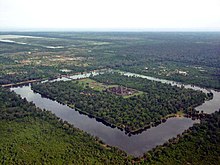
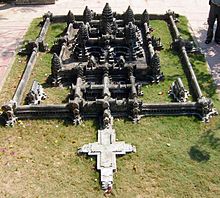




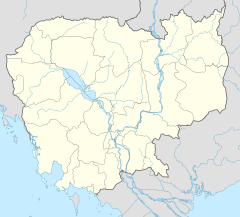

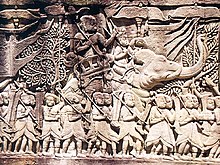
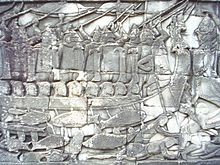
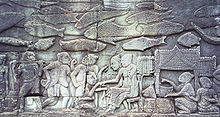
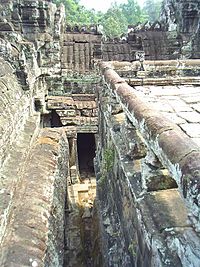


![Location of Cambodia (green)in ASEAN (dark grey) — [Legend]](http://upload.wikimedia.org/wikipedia/commons/thumb/9/91/Location_Cambodia_ASEAN.svg/250px-Location_Cambodia_ASEAN.svg.png)

